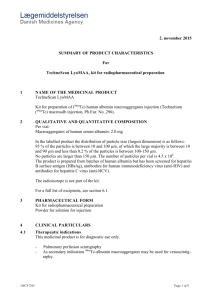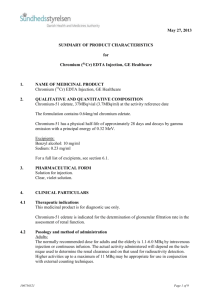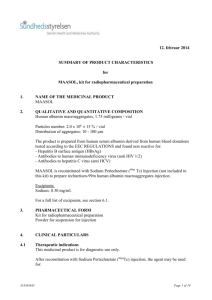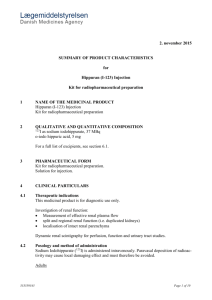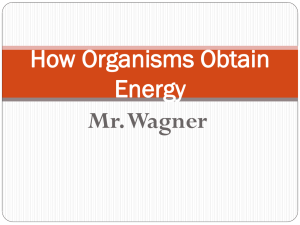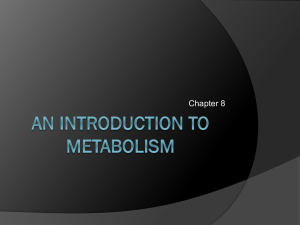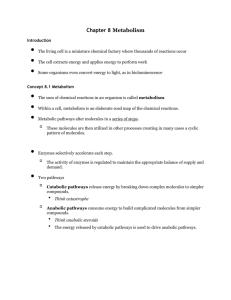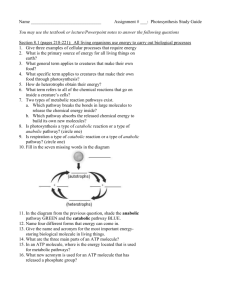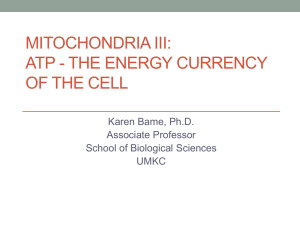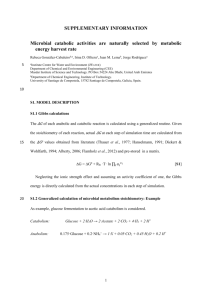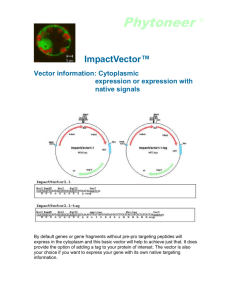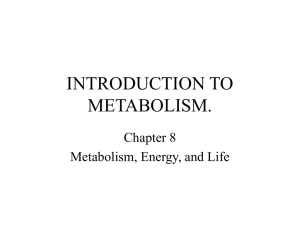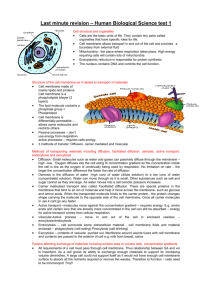Supplementary Tables
advertisement
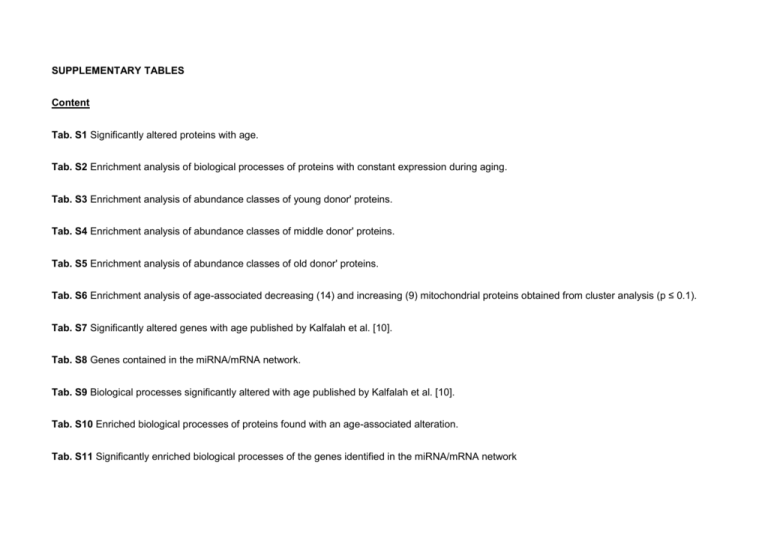
SUPPLEMENTARY TABLES Content Tab. S1 Significantly altered proteins with age. Tab. S2 Enrichment analysis of biological processes of proteins with constant expression during aging. Tab. S3 Enrichment analysis of abundance classes of young donor' proteins. Tab. S4 Enrichment analysis of abundance classes of middle donor' proteins. Tab. S5 Enrichment analysis of abundance classes of old donor' proteins. Tab. S6 Enrichment analysis of age-associated decreasing (14) and increasing (9) mitochondrial proteins obtained from cluster analysis (p ≤ 0.1). Tab. S7 Significantly altered genes with age published by Kalfalah et al. [10]. Tab. S8 Genes contained in the miRNA/mRNA network. Tab. S9 Biological processes significantly altered with age published by Kalfalah et al. [10]. Tab. S10 Enriched biological processes of proteins found with an age-associated alteration. Tab. S11 Significantly enriched biological processes of the genes identified in the miRNA/mRNA network Table S1 Significantly altered proteins with age. Quantitative label-free proteome analysis of in situ aged fibroblasts' proteome revealed 43 proteins that are differentially altered during in situ ageing (ANOVA: p ≤ 0.05; Pearson correlation: p ≤ 0.05). For ANOVA analysis donors were grouped according to calendar age into groups 20-30, 40-50 and 60-70 years, with five individual donors in each group. Accessio n Gene Description Lowest condition Highest condition 30 Young Old Constant expression during ageing Yes P08133 ANXA6 Annexin A6 0.001 1.5 up 1985 33 P47897 QARS Glutaminyl-tRNA synthetase 0.002 1.3 up 216 6 6 Young Old Yes P11717 IGF2R 0.003 2.8 up Q6IBS0 TWF2 Cation-independent mannose-6phosphate receptor Twinfilin-2 77 2 2 Young Old Yes 0.005 1.4 down 223 4 3 Old Young Yes P46782 RPS5 40S ribosomal protein S5 0.007 2.2 down 134 2 2 Old Young Yes O43143 DHX15 Q99460 PSMD1 P62273 RPS29 Putative pre-mRNA-splicing factor ATPdependent RNA helicase DHX15 26S proteasome non-ATPase regulatory subunit 1 40S ribosomal protein S29 0.008 1.4 up 136 3 3 Young Old Yes 0.012 1.4 down 362 7 5 Old Young Yes 0.012 1.3 up 140 2 2 Young Old Yes Q9UMS6 P40227 SYNPO 2 CCT6A Synaptopodin-2 0.012 1.8 up 96 2 2 Young Old No T-complex protein 1 subunit zeta 0.012 1.7 down 860 12 7 Old Young Yes P08758 ANXA5 Annexin A5 0.012 1.4 up 1967 22 22 Young Old Yes Q9Y3I0 tRNA-splicing ligase RtcB homolog 0.013 2.8 down 251 5 3 Old Young Yes Q13242 C22orf2 8 SRSF9 Serine/arginine-rich splicing factor 9 0.013 1.2 up 89 3 2 Young Old Yes P60660 MYL6 Myosin light polypeptide 6 0.017 1.2 up 597 7 7 Young Old Yes Q15435 PPP1R7 0.022 1.6 down 290 4 4 Old Mid Yes Q9Y224 C14orf1 66 PSMD1 4 Protein phosphatase 1 regulatory subunit 7 UPF0568 protein C14orf166 0.022 1.9 down 398 6 6 Old Young Yes 26S proteasome non-ATPase regulatory subunit 14 0.022 1.4 down 184 4 4 Old Young Yes O00487 p-value Fold change Regulati on Confidence score Peptide count Peptides quantitation P34897 SHMT2 P08107 0.022 1.7 down HSPA1A Serine hydroxymethyltransferase, mitochondrial Heat shock 70 kDa protein 1A/1B 145 3 3 Old Young Yes 0.022 1.7 up 1160 19 9 Young Old Yes Q92499 DDX1 ATP-dependent RNA helicase DDX1 0.023 1.3 down 332 8 7 Old Young Yes P62158 CALM1 Calmodulin 0.024 2.7 up 238 3 3 Young Old Yes O94973 AP2A2 AP-2 complex subunit alpha-2 0.027 1.6 down 347 6 3 Old Young Yes Q92974 P09525 ARHGE F2 ANXA4 Rho guanine nucleotide exchange factor 2 0.028 2.6 down 65 2 2 Old Mid Yes Annexin A4 0.030 1.3 up 369 5 5 Young Mid Yes P27105 STOM Erythrocyte band 7 integral membrane protein ATP-dependent RNA helicase DDX3X 0.031 2.0 up 237 4 3 Young Old No O00571 DDX3X 0.034 1.3 down 576 10 10 Old Young No P04632 CAPNS 1 NQO1 Calpain small subunit 1 0.034 1.6 down 287 4 3 Old Mid Yes NAD(P)H dehydrogenase [quinone] 1 0.035 3.2 up 122 3 3 Young Old No Protein S100-A16 0.036 1.4 down 99 2 2 Old Young No P09497 S100A1 6 CLTB Clathrin light chain B 0.037 1.5 up 199 6 3 Young Old No P80723 BASP1 Brain acid soluble protein 1 0.037 1.6 up 1070 13 13 Young Old Yes Q13217 DNAJC3 DnaJ homolog subfamily C member 3 0.037 2.6 down 137 2 2 Old Young Yes O95782 AP2A1 AP-2 complex subunit alpha-1 0.039 1.4 down 541 10 6 Old Young Yes P62753 RPS6 40S ribosomal protein S6 0.039 1.3 up Yes P41250 GARS Glycyl-tRNA synthetase 0.039 1.2 down Q9NZN4 EHD2 EH domain-containing protein 2 0.039 1.4 Q9Y3B8 REXO2 Oligoribonuclease, mitochondrial 0.040 2.5 P07996 THBS1 Thrombospondin-1 0.044 P30419 NMT1 0.045 Q01518 CAP1 Glycylpeptide N-tetradecanoyltransferase 1 Adenylyl cyclase-associated protein 1 P54652 HSPA2 Heat shock-related 70 kDa protein 2 Q96QV6 HIST1H 2AA TCP1 P15559 Q96FQ6 P17987 122 3 3 Young Old 1077 17 15 Old Young up 922 19 17 Young Mid Yes down 158 2 2 Old Young Yes 1.5 up 780 15 14 Young Old 1.4 down 88 2 2 Old Young Yes 0.048 1.1 down 1234 18 17 Old Young Yes 0.048 1.5 up 866 13 2 Young Mid No Histone H2A type 1-A 0.049 3.8 down 375 5 2 Old Young No T-complex protein 1 subunit alpha 0.050 1.2 down 723 13 11 Old Mid No No Yes Table S2 Enrichment analysis of biological processes of proteins with constant expression during aging. The entire identified proteome was used as background list. Enrichment was applied on Gene Ontology, Reactome, Wikipathways and Pathway Interaction Database biological processes. We discarded gene sets that were redundant, had < 5 members or a p-value above 0.01. Biological process Set size Candidates p-value q-value Translation 160(115) 82 (71.3%) 5.66E-10 5.47E-08 Cap-dependent Translation Initiation 124(92) 68 (73.9%) 1.63E-09 5.47E-08 Eukaryotic Translation Initiation 124(92) 68 (73.9%) 1.63E-09 5.47E-08 Eukaryotic Translation Elongation 100(77) 59 (76.6%) 2.04E-09 5.47E-08 GTP hydrolysis and joining of the 60S ribosomal subunit 117(91) 67 (73.6%) 2.90E-09 5.47E-08 L13a-mediated translational silencing of Ceruloplasmin expression 115(91) 67 (73.6%) 2.90E-09 5.47E-08 3, -UTR-mediated translational regulation 116(91) 67 (73.6%) 2.90E-09 5.47E-08 Formation of a pool of free 40S subunits 105(81) 61 (75.3%) 3.56E-09 5.50E-08 Nonsense Mediated Decay Independent of the Exon Junction Complex 99(75) 57 (76.0%) 6.80E-09 8.89E-08 Metabolism of proteins 532(194) 122 (62.9%) 8.87E-09 9.89E-08 Eukaryotic Translation Termination 93(72) 55 (76.4%) 9.31E-09 9.89E-08 Regulation of gene expression in beta cells 105(71) 54 (76.1%) 1.69E-08 1.69E-07 Nonsense Mediated Decay Enhanced by the Exon Junction Complex 110(78) 58 (74.4%) 2.04E-08 1.80E-07 Nonsense-Mediated Decay 110(78) 58 (74.4%) 2.04E-08 1.80E-07 Peptide chain elongation 94(73) 55 (75.3%) 2.22E-08 1.80E-07 Cytoplasmic Ribosomal Proteins 88(70) 53 (75.7%) 3.06E-08 2.36E-07 Viral mRNA Translation 93(72) 54 (75.0%) 3.98E-08 2.94E-07 SRP-dependent cotranslational protein targeting to membrane 118(87) 62 (71.3%) 9.65E-08 6.84E-07 Insulin Synthesis and Processing 130(89) 63 (70.8%) 1.14E-07 7.73E-07 Metabolism of mRNA 178(99) 68 (68.7%) 2.27E-07 1.49E-06 Gene Expression 1064(267) 152 (56.9%) 1.55E-06 9.73E-06 Translation initiation complex formation 61(50) 38 (76.0%) 2.76E-06 1.57E-05 Activation of the mRNA upon binding of the cap-binding complex and eIFs, and subsequent binding to 43S 63(50) 38 (76.0%) 2.76E-06 1.57E-05 Metabolism of RNA 226(111) 72 (64.9%) 3.06E-06 1.68E-05 Ribosomal scanning and start codon recognition 61(49) 37 (75.5%) 4.95E-06 2.55E-05 Processing of Capped Intron-Containing Pre-mRNA 35(18) 17 (94.4%) 7.88E-06 3.94E-05 Formation of the ternary complex, and subsequently, the 43S complex 55(43) 33 (76.7%) 9.13E-06 mRNA Processing 126(54) 39 (72.2%) 1.69E-05 7.55E-05 mRNA Splicing - Major Pathway 107(53) 37 (69.8%) 9.42E-05 0.000391 mRNA Splicing 107(53) 37 (69.8%) 9.42E-05 0.000391 Cytosolic tRNA aminoacylation 24(22) 18 (81.8%) 0.000287 0.00113 tRNA Aminoacylation 42(23) 18 (78.3%) 0.000783 0.00283 proteasome complex 24(21) 16 (76.2%) 0.00258 0.00914 4.31E-05 Table S3 Enrichment analysis of abundance classes of young donor' proteins. Enrichment analysis was carried out using DAVID and Gene Ontology biological processes. We discarded processes that had a p-value above 0.05. GO ID Term GO:0006414 translational elongation Count 36 GO:0006457 protein folding GO:0007010 cytoskeleton organization GO:0030029 GO:0048870 % P-Value Fisher Exact Fold Enrichment 9.4 4.1E-06 1.4E-06 2.1 Class I 28 7.3 1.7E-05 4.9E-06 2.2 I 40 10.5 5.0E-05 2.1E-05 1.8 I actin filament-based process 29 7.6 1.4E-04 5.0E-05 2.0 I cell motility 29 7.6 2.6E-04 9.8E-05 1.9 I GO:0030036 actin cytoskeleton organization 28 7.3 2.8E-04 1.1E-04 1.9 I GO:0006007 glucose catabolic process 16 4.2 4.2E-04 1.0E-04 2.5 I GO:0019320 hexose catabolic process 16 4.2 4.2E-04 1.0E-04 2.5 I GO:0006412 translation 50 13.1 8.8E-04 4.8E-04 1.5 I GO:0043067 regulation of programmed cell death 45 11.8 9.8E-04 5.2E-04 1.6 I GO:0046365 monosaccharide catabolic process 16 4.2 1.0E-03 2.9E-04 2.3 I GO:0010941 regulation of cell death 45 11.8 1.2E-03 6.3E-04 1.5 I GO:0042981 regulation of apoptosis 44 11.5 1.3E-03 7.2E-04 1.5 I GO:0006096 glycolysis 13 3.4 1.5E-03 3.4E-04 2.5 I GO:0046164 alcohol catabolic process 16 4.2 1.6E-03 4.6E-04 2.2 I GO:0051789 response to protein stimulus 14 3.7 1.6E-03 4.0E-04 2.4 I GO:0006986 response to unfolded protein 12 3.1 2.2E-03 5.1E-04 2.6 I GO:0032535 regulation of cellular component size 20 5.2 2.5E-03 9.2E-04 2.0 I GO:0030834 regulation of actin filament depolymerization 9 2.4 2.5E-03 3.7E-04 3.1 I GO:0051129 negative regulation of cellular component organization 16 4.2 3.3E-03 1.1E-03 2.1 I GO:0044275 cellular carbohydrate catabolic process 16 4.2 3.3E-03 1.1E-03 2.1 I GO:0043623 cellular protein complex assembly 16 4.2 3.3E-03 1.1E-03 2.1 I GO:0043244 regulation of protein complex disassembly 12 3.1 3.6E-03 9.0E-04 2.4 I GO:0016052 carbohydrate catabolic process 17 4.5 4.3E-03 1.5E-03 2.0 I GO:0006006 glucose metabolic process 19 5.0 4.9E-03 1.9E-03 1.9 I GO:0060548 negative regulation of cell death 23 6.0 5.3E-03 2.3E-03 1.7 I GO:0043069 negative regulation of programmed cell death 23 6.0 5.3E-03 2.3E-03 1.7 I GO:0070271 protein complex biogenesis 32 8.4 6.1E-03 3.2E-03 1.6 I GO:0006461 protein complex assembly GO:0051258 protein polymerization GO:0008064 regulation of actin polymerization or depolymerization GO:0030832 regulation of actin filament length GO:0043066 negative regulation of apoptosis GO:0019725 GO:0010033 32 8.4 6.1E-03 3.2E-03 1.6 I 8 2.1 7.0E-03 1.2E-03 3.0 I 12 3.1 8.3E-03 2.4E-03 2.2 I 12 3.1 8.3E-03 2.4E-03 2.2 I 22 5.8 9.5E-03 4.3E-03 1.7 I cellular homeostasis 23 6.0 1.0E-02 4.9E-03 1.7 I response to organic substance 36 9.4 1.0E-02 5.8E-03 1.5 I GO:0032956 regulation of actin cytoskeleton organization 13 3.4 1.1E-02 3.7E-03 2.1 I GO:0032970 regulation of actin filament-based process 13 3.4 1.1E-02 3.7E-03 2.1 I GO:0045454 cell redox homeostasis 13 3.4 1.1E-02 3.7E-03 2.1 I GO:0010639 negative regulation of organelle organization 11 2.9 1.3E-02 3.7E-03 2.2 I GO:0043242 negative regulation of protein complex disassembly 9 2.4 1.3E-02 3.1E-03 2.5 I GO:0045664 regulation of neuron differentiation 9 2.4 1.3E-02 3.1E-03 2.5 I GO:0007051 spindle organization 6 1.6 1.6E-02 2.2E-03 3.4 I GO:0043066 anti-apoptosis 16 4.2 1.9E-02 8.1E-03 1.8 I GO:0030835 negative regulation of actin filament depolymerization GO:0050767 regulation of neurogenesis GO:0046496 GO:0019362 7 1.8 1.9E-02 3.7E-03 2.9 I 10 2.6 1.9E-02 5.6E-03 2.2 I nicotinamide nucleotide metabolic process 8 2.1 2.0E-02 4.7E-03 2.6 I pyridine nucleotide metabolic process 8 2.1 2.0E-02 4.7E-03 2.6 I GO:0009820 alkaloid metabolic process 8 2.1 2.0E-02 4.7E-03 2.6 I GO:0009266 response to temperature stimulus 8 2.1 2.0E-02 4.7E-03 2.6 I GO:0006733 oxidoreduction coenzyme metabolic process 8 2.1 2.0E-02 4.7E-03 2.6 I GO:0006769 nicotinamide metabolic process 8 2.1 2.0E-02 4.7E-03 2.6 I GO:0019318 hexose metabolic process 19 5.0 2.1E-02 9.8E-03 1.7 I GO:0051493 regulation of cytoskeleton organization 17 4.5 2.2E-02 9.6E-03 1.7 I GO:0010035 response to inorganic substance 18 4.7 2.4E-02 1.1E-02 1.7 I GO:0032271 regulation of protein polymerization 11 2.9 2.5E-02 8.5E-03 2.1 I GO:0033043 regulation of organelle organization 19 5.0 2.6E-02 1.2E-02 1.6 I GO:0001666 response to hypoxia 10 2.6 2.7E-02 8.7E-03 2.1 I GO:0045596 negative regulation of cell differentiation 10 2.6 2.7E-02 8.7E-03 2.1 I GO:0051960 regulation of nervous system development 10 2.6 2.7E-02 8.7E-03 2.1 I GO:0043488 regulation of mRNA stability 6 1.6 3.0E-02 5.3E-03 3.0 I GO:0043487 regulation of RNA stability GO:0010975 regulation of neuron projection development GO:0043933 macromolecular complex subunit organization GO:0070482 response to oxygen levels GO:0042592 homeostatic process GO:0065003 GO:0043933 GO:0019748 6 1.6 3.0E-02 5.3E-03 3.0 I 7 1.8 3.1E-02 7.1E-03 2.6 I 41 10.8 3.5E-02 2.3E-02 1.3 I 10 2.6 3.7E-02 1.3E-02 2.0 I 28 7.3 3.7E-02 2.2E-02 1.4 I macromolecular complex assembly 39 10.2 3.9E-02 2.6E-02 1.3 I cellular macromolecular complex subunit organization 27 7.1 4.1E-02 2.4E-02 1.4 I secondary metabolic process 9 2.4 4.1E-02 1.3E-02 2.1 I GO:0051494 negative regulation of cytoskeleton organization 9 2.4 4.1E-02 1.3E-02 2.1 I GO:0010638 positive regulation of organelle organization 8 2.1 4.4E-02 1.3E-02 2.2 I GO:0044087 regulation of cellular component biogenesis 13 3.4 4.4E-02 1.9E-02 1.8 I GO:0009611 response to wounding 19 5.0 4.5E-02 2.3E-02 1.6 I GO:0050818 regulation of coagulation 5 1.3 4.7E-02 7.5E-03 3.2 I GO:0032844 regulation of homeostatic process 5 1.3 4.7E-02 7.5E-03 3.2 I GO:0030199 collagen fibril organization 7 1.8 4.8E-02 1.3E-02 2.4 I GO:0050878 regulation of body fluid levels 7 1.8 4.8E-02 1.3E-02 2.4 I GO:0051146 striated muscle cell differentiation 7 1.8 4.8E-02 1.3E-02 2.4 I GO:2000146 negative regulation of cell motility GO:0000226 microtubule cytoskeleton organization GO:0051693 GO:0009408 7 1.8 4.8E-02 1.3E-02 2.4 I 10 2.6 4.9E-02 1.8E-02 2.0 I actin filament capping 6 1.6 4.9E-02 1.1E-02 2.7 I response to heat 6 1.6 4.9E-02 1.1E-02 2.7 I GO:0034614 cellular response to reactive oxygen species 6 1.6 4.9E-02 1.1E-02 2.7 I GO:0051495 positive regulation of cytoskeleton organization 6 1.6 4.9E-02 1.1E-02 2.7 I GO:0051130 positive regulation of cellular component organization 12 3.1 5.0E-02 2.1E-02 1.8 I GO:0006412 translation 50 12.5 5.7E-04 3.1E-04 1.5 II GO:0032270 positive regulation of cellular protein metabolic process 23 5.8 1.1E-03 4.2E-04 1.9 II GO:0050905 neuromuscular process 7 1.8 1.9E-03 1.5E-04 4.0 II GO:0031396 regulation of protein ubiquitination 19 4.8 2.2E-03 7.7E-04 2.0 II GO:0031401 positive regulation of protein modification process 21 5.3 2.4E-03 9.3E-04 1.9 II GO:0010604 positive regulation of macromolecule metabolic process 33 8.3 2.7E-03 1.4E-03 1.6 II GO:0006414 translational elongation 28 7.0 5.3E-03 2.6E-03 1.6 II GO:0050885 neuromuscular process controlling balance 6 1.5 6.8E-03 6.1E-04 3.9 II GO:0044092 negative regulation of molecular function 24 6.0 7.4E-03 3.4E-03 1.7 II GO:0019941 modification-dependent protein catabolic process 31 7.8 7.6E-03 4.0E-03 1.6 II GO:0043632 modification-dependent macromolecule catabolic process 31 7.8 7.6E-03 4.0E-03 1.6 II GO:0043086 negative regulation of catalytic activity 22 5.5 9.6E-03 4.4E-03 1.7 II GO:0031399 regulation of protein modification process 23 5.8 1.0E-02 4.9E-03 1.7 II GO:0030163 protein catabolic process 32 8.0 1.1E-02 6.1E-03 1.5 II GO:0006357 regulation of transcription from RNA polymerase II promoter 18 4.5 1.3E-02 5.4E-03 1.8 II GO:0006511 ubiquitin-dependent protein catabolic process 24 6.0 1.3E-02 6.7E-03 1.6 II GO:0044257 cellular protein catabolic process 31 7.8 1.7E-02 9.8E-03 1.5 II GO:0051603 proteolysis involved in cellular protein catabolic process 31 7.8 1.7E-02 9.8E-03 1.5 II GO:0022402 cell cycle process 34 8.5 1.8E-02 1.1E-02 1.4 II GO:0010498 proteasomal protein catabolic process 19 4.8 1.8E-02 8.1E-03 1.7 II GO:0043161 proteasomal ubiquitin-dependent protein catabolic process 19 4.8 1.8E-02 8.1E-03 1.7 II GO:0032269 negative regulation of cellular protein metabolic process 22 5.5 2.1E-02 1.1E-02 1.6 II GO:0032268 regulation of cellular protein metabolic process 33 8.3 2.1E-02 1.2E-02 1.4 II GO:0031400 negative regulation of protein modification process 18 4.5 3.0E-02 1.5E-02 1.6 II GO:0051248 negative regulation of protein metabolic process 22 5.5 3.0E-02 1.6E-02 1.5 II GO:0009057 macromolecule catabolic process 36 9.0 3.5E-02 2.2E-02 1.4 II GO:0044093 positive regulation of molecular function 31 7.8 4.5E-02 2.8E-02 1.4 II GO:0007040 lysosome organization 5 1.3 4.5E-02 6.9E-03 3.3 II GO:0009065 glutamine family amino acid catabolic process 5 1.3 4.5E-02 6.9E-03 3.3 II GO:0006508 proteolysis 41 10.3 4.6E-02 3.1E-02 1.3 II GO:0009063 cellular amino acid catabolic process 6 1.5 4.6E-02 9.9E-03 2.7 II GO:0006508 proteolysis 41 10.5 1.6E-02 1.0E-02 1.4 III GO:0042775 mitochondrial ATP synthesis coupled electron transport GO:0006886 intracellular protein transport GO:0046112 GO:0042440 GO:0044265 GO:0012501 8 2.0 2.0E-02 4.7E-03 2.6 III 31 7.9 2.1E-02 1.3E-02 1.5 III nucleobase biosynthetic process 5 1.3 3.5E-02 5.1E-03 3.5 III pigment metabolic process 6 1.5 3.5E-02 7.0E-03 2.9 III cellular macromolecule catabolic process 32 8.2 4.4E-02 2.8E-02 1.4 III programmed cell death 25 6.6 3.9E-03 1.8E-03 1.8 IV GO:0010942 positive regulation of cell death 20 5.3 5.3E-03 2.3E-03 1.9 IV GO:0008219 cell death 29 7.7 5.6E-03 2.9E-03 1.6 IV GO:0006631 fatty acid metabolic process 11 2.9 2.5E-02 9.1E-03 2.1 IV GO:0006796 phosphate metabolic process 28 7.4 3.2E-02 1.9E-02 1.5 IV GO:0006915 induction of apoptosis 13 3.4 4.5E-02 2.0E-02 1.8 IV GO:0012502 induction of programmed cell death 13 3.4 4.5E-02 2.0E-02 1.8 IV GO:0022406 membrane docking 5 1.3 4.9E-02 9.2E-03 3.3 IV Table S4 Enrichment analysis of abundance classes of middle donor' proteins. Enrichment analysis was carried out using DAVID and Gene Ontology biological processes. We discarded processes that had a p-value above 0.05. GO ID Term GO:0006414 translational elongation Count 37 GO:0006457 protein folding GO:0007010 cytoskeleton organization GO:0048870 GO:0030029 % P-Value Fisher Exact Fold Enrichment 9.4 2.1E-06 7.0E-07 2.1 Class I 28 7.1 2.5E-05 7.5E-06 2.2 I 40 10.2 8.1E-05 3.5E-05 1.8 I cell motility 30 7.6 1.4E-04 5.1E-05 1.9 I actin filament-based process 29 7.4 2.0E-04 7.5E-05 1.9 I GO:0007015 actin filament organization 14 3.6 2.2E-04 4.1E-05 2.8 I GO:0030036 actin cytoskeleton organization 28 7.1 4.0E-04 1.5E-04 1.9 I GO:0043067 regulation of programmed cell death 46 11.7 7.8E-04 4.1E-04 1.6 I GO:0010941 regulation of cell death 46 11.7 9.5E-04 5.1E-04 1.5 I GO:0042981 regulation of apoptosis 45 11.4 1.1E-03 5.7E-04 1.5 I GO:0006096 glycolysis 13 3.3 1.8E-03 4.2E-04 2.5 I GO:0051789 response to protein stimulus 14 3.6 1.9E-03 5.0E-04 2.4 I GO:0006007 glucose catabolic process 15 3.8 2.0E-03 5.5E-04 2.3 I GO:0019320 hexose catabolic process 15 3.8 2.0E-03 5.5E-04 2.3 I GO:0007051 spindle organization 7 1.8 2.4E-03 1.9E-04 3.8 I GO:0006412 translation 49 12.4 2.6E-03 1.5E-03 1.5 I GO:0006986 response to unfolded protein 12 3.0 2.7E-03 6.2E-04 2.5 I GO:0030834 regulation of actin filament depolymerization 9 2.3 2.8E-03 4.4E-04 3.0 I GO:0060548 negative regulation of cell death 24 6.1 3.0E-03 1.3E-03 1.8 I GO:0043069 negative regulation of programmed cell death 24 6.1 3.0E-03 1.3E-03 1.8 I GO:0032535 regulation of cellular component size 20 5.1 3.2E-03 1.2E-03 1.9 I GO:0044275 cellular carbohydrate catabolic process 16 4.1 4.1E-03 1.4E-03 2.1 I GO:0051129 negative regulation of cellular component organization 16 4.1 4.1E-03 1.4E-03 2.1 I GO:0043623 cellular protein complex assembly 16 4.1 4.1E-03 1.4E-03 2.1 I GO:0043244 regulation of protein complex disassembly 12 3.0 4.3E-03 1.1E-03 2.4 I GO:0046365 monosaccharide catabolic process 15 3.8 4.3E-03 1.3E-03 2.1 I GO:0043066 negative regulation of apoptosis 23 5.8 5.4E-03 2.4E-03 1.7 I GO:0016052 carbohydrate catabolic process 17 4.3 5.4E-03 1.9E-03 2.0 I GO:0046164 alcohol catabolic process 15 3.8 6.0E-03 2.0E-03 2.1 I GO:0006006 glucose metabolic process 19 4.8 6.1E-03 2.4E-03 1.9 I GO:0019725 cellular homeostasis 24 6.1 6.2E-03 2.8E-03 1.7 I GO:0050767 regulation of neurogenesis 11 2.8 6.4E-03 1.6E-03 2.4 I GO:0051258 protein polymerization 8 2.0 7.9E-03 1.4E-03 2.9 I GO:0070271 protein complex biogenesis 32 8.1 8.4E-03 4.5E-03 1.5 I GO:0006461 protein complex assembly 32 8.1 8.4E-03 4.5E-03 1.5 I GO:0043066 anti-apoptosis 17 4.3 9.6E-03 3.8E-03 1.9 I GO:0030832 regulation of actin filament length 12 3.0 9.7E-03 2.9E-03 2.2 I GO:0008064 regulation of actin polymerization or depolymerization 12 3.0 9.7E-03 2.9E-03 2.2 I GO:0051960 regulation of nervous system development 11 2.8 9.9E-03 2.7E-03 2.3 I GO:0051493 regulation of cytoskeleton organization 18 4.6 1.1E-02 4.8E-03 1.8 I GO:0032970 regulation of actin filament-based process 13 3.3 1.3E-02 4.5E-03 2.0 I GO:0032956 regulation of actin cytoskeleton organization 13 3.3 1.3E-02 4.5E-03 2.0 I GO:0045454 cell redox homeostasis 13 3.3 1.3E-02 4.5E-03 2.0 I GO:0010033 response to organic substance 36 9.1 1.4E-02 8.2E-03 1.4 I GO:0010639 negative regulation of organelle organization 11 2.8 1.4E-02 4.4E-03 2.2 I GO:0033043 regulation of organelle organization 20 5.1 1.5E-02 6.8E-03 1.7 I GO:0042592 homeostatic process 30 7.6 1.5E-02 8.2E-03 1.5 I GO:0043242 negative regulation of protein complex disassembly 9 2.3 1.5E-02 3.6E-03 2.5 I GO:0045664 regulation of neuron differentiation 9 2.3 1.5E-02 3.6E-03 2.5 I GO:0010638 positive regulation of organelle organization GO:0000226 microtubule cytoskeleton organization GO:0030835 negative regulation of actin filament depolymerization GO:0008015 GO:0003013 GO:0009266 response to temperature stimulus GO:0051130 positive regulation of cellular component organization GO:0019318 hexose metabolic process GO:0032271 regulation of protein polymerization GO:0010035 GO:0043933 9 2.3 1.5E-02 3.6E-03 2.5 I 11 2.8 2.1E-02 6.7E-03 2.1 I 7 1.8 2.1E-02 4.2E-03 2.8 I blood circulation 10 2.5 2.2E-02 6.6E-03 2.2 I circulatory system process 10 2.5 2.2E-02 6.6E-03 2.2 I 8 2.0 2.2E-02 5.4E-03 2.5 I 13 3.3 2.4E-02 9.1E-03 1.9 I 19 4.8 2.6E-02 1.2E-02 1.6 I 11 2.8 2.8E-02 9.9E-03 2.0 I response to inorganic substance 18 4.6 2.9E-02 1.4E-02 1.6 I macromolecular complex subunit organization 42 10.7 3.0E-02 2.0E-02 1.3 I GO:0043933 cellular macromolecular complex subunit organization 28 7.1 3.0E-02 1.7E-02 1.4 I GO:0001666 response to hypoxia 10 2.5 3.1E-02 1.0E-02 2.1 I GO:0045596 negative regulation of cell differentiation 10 2.5 3.1E-02 1.0E-02 2.1 I GO:0043488 regulation of mRNA stability 6 1.5 3.3E-02 5.9E-03 2.9 I GO:0043487 regulation of RNA stability 6 1.5 3.3E-02 5.9E-03 2.9 I GO:0065003 macromolecular complex assembly 40 10.2 3.4E-02 2.2E-02 1.3 I GO:0010975 regulation of neuron projection development 7 1.8 3.4E-02 8.0E-03 2.6 I GO:0060284 regulation of cell development 11 2.8 3.8E-02 1.4E-02 1.9 I GO:0034622 cellular macromolecular complex assembly 25 6.3 4.2E-02 2.4E-02 1.4 I GO:0070482 response to oxygen levels 10 2.5 4.2E-02 1.5E-02 2.0 I GO:0051235 maintenance of location 9 2.3 4.6E-02 1.5E-02 2.1 I GO:0051494 negative regulation of cytoskeleton organization 9 2.3 4.6E-02 1.5E-02 2.1 I GO:0032268 regulation of cellular protein metabolic process 41 10.0 1.8E-04 8.3E-05 1.7 II GO:0031398 positive regulation of protein ubiquitination 21 5.1 2.9E-04 8.7E-05 2.2 II GO:0006412 translation 52 12.7 4.5E-04 2.4E-04 1.5 II GO:0051247 positive regulation of protein metabolic process 25 6.1 5.3E-04 1.9E-04 2.0 II GO:0031401 positive regulation of protein modification process 23 5.6 5.9E-04 2.0E-04 2.0 II GO:0051444 negative regulation of ubiquitin-protein ligase activity 19 4.7 6.4E-04 1.9E-04 2.2 II GO:0051352 negative regulation of ligase activity 19 4.7 6.4E-04 1.9E-04 2.2 II GO:0031397 negative regulation of protein ubiquitination 19 4.7 6.4E-04 1.9E-04 2.2 II GO:0031145 anaphase-promoting complex-dependent proteasomal ubiquitin-dependent protein catabolic process 19 4.7 6.4E-04 1.9E-04 2.2 II GO:0051436 negative regulation of ubiquitin-protein ligase activity during mitotic cell cycle 19 4.7 6.4E-04 1.9E-04 2.2 II GO:0031399 regulation of protein modification process 27 6.6 6.4E-04 2.5E-04 1.9 II GO:0032269 negative regulation of cellular protein metabolic process 26 6.4 1.6E-03 6.7E-04 1.8 II GO:0019941 modification-dependent protein catabolic process 34 8.3 1.9E-03 9.1E-04 1.6 II GO:0043632 modification-dependent macromolecule catabolic process 34 8.3 1.9E-03 9.1E-04 1.6 II GO:0051248 negative regulation of protein metabolic process 26 6.4 2.7E-03 1.2E-03 1.7 II GO:0010604 positive regulation of macromolecule metabolic process 34 8.3 2.8E-03 1.4E-03 1.6 II GO:0030163 protein catabolic process 35 8.6 3.1E-03 1.6E-03 1.6 II GO:0031400 negative regulation of protein modification process 21 5.1 4.2E-03 1.7E-03 1.8 II GO:0009057 macromolecule catabolic process 41 10.0 4.6E-03 2.6E-03 1.5 II GO:0044265 cellular macromolecule catabolic process 39 9.6 4.9E-03 2.7E-03 1.5 II GO:0051603 proteolysis involved in cellular protein catabolic process 34 8.3 5.1E-03 2.7E-03 1.5 II GO:0044257 cellular protein catabolic process 34 8.3 5.1E-03 2.7E-03 1.5 II GO:0006511 ubiquitin-dependent protein catabolic process 26 6.4 5.4E-03 2.5E-03 1.7 II GO:0044092 negative regulation of molecular function 25 6.1 6.0E-03 2.8E-03 1.7 II GO:0043086 negative regulation of catalytic activity 23 5.6 7.4E-03 3.4E-03 1.7 II GO:0006414 translational elongation 28 6.9 9.9E-03 5.1E-03 1.6 II GO:0043161 proteasomal ubiquitin-dependent protein catabolic process 20 4.9 1.3E-02 5.7E-03 1.7 II GO:0010498 proteasomal protein catabolic process 20 4.9 1.3E-02 5.7E-03 1.7 II GO:0010605 negative regulation of macromolecule metabolic process 37 9.1 1.4E-02 8.1E-03 1.4 II GO:0003006 reproductive developmental process 10 2.5 1.5E-02 4.3E-03 2.3 II GO:0050905 neuromuscular process 6 1.5 1.8E-02 2.5E-03 3.3 II GO:0043085 positive regulation of catalytic activity 30 7.4 1.9E-02 1.1E-02 1.5 II GO:0009310 amine catabolic process 7 1.7 2.2E-02 4.3E-03 2.8 II GO:0006508 proteolysis 44 10.8 2.4E-02 1.6E-02 1.3 II GO:0044093 positive regulation of molecular function 33 8.1 2.8E-02 1.7E-02 1.4 II GO:0006413 translational initiation 10 2.5 3.2E-02 1.0E-02 2.1 II GO:0022402 cell cycle process 34 8.3 3.3E-02 2.1E-02 1.4 II GO:0048610 reproductive cellular process 8 2.0 3.5E-02 9.6E-03 2.3 II GO:0006357 regulation of transcription from RNA polymerase II promoter 17 4.2 4.1E-02 2.0E-02 1.6 II GO:0034660 ncRNA metabolic process 17 4.2 5.0E-02 2.5E-02 1.6 II GO:0042775 mitochondrial ATP synthesis coupled electron transport 9 2.4 3.4E-03 6.1E-04 3.1 III GO:0045333 cellular respiration 14 3.7 1.0E-02 3.8E-03 2.1 III GO:0015980 energy derivation by oxidation of organic compounds 17 4.5 1.5E-02 6.4E-03 1.8 III GO:0006120 mitochondrial electron transport. NADH to ubiquinone 7 1.8 2.6E-02 5.9E-03 2.8 III GO:0046907 intracellular transport 47 12.3 2.7E-02 1.8E-02 1.3 III GO:0042440 pigment metabolic process 6 1.6 2.9E-02 5.4E-03 3.1 III GO:0046112 nucleobase biosynthetic process 5 1.3 3.0E-02 4.1E-03 3.7 III GO:0006886 intracellular protein transport 29 7.6 3.4E-02 2.1E-02 1.4 III GO:0070727 cellular macromolecule localization 30 7.9 3.7E-02 2.2E-02 1.4 III GO:0033365 protein localization in organelle 12 3.1 4.1E-02 1.7E-02 1.9 III GO:0006913 nucleocytoplasmic transport 14 3.7 4.1E-02 1.8E-02 1.8 III GO:0051169 nuclear transport 14 3.7 4.1E-02 1.8E-02 1.8 III GO:0012501 programmed cell death 24 6.6 5.9E-03 2.8E-03 1.7 IV GO:0008219 cell death 28 7.7 7.5E-03 3.9E-03 1.6 IV GO:0006631 fatty acid metabolic process 11 3.0 2.1E-02 7.4E-03 2.2 IV GO:0006796 phosphate metabolic process 27 7.4 4.0E-02 2.4E-02 1.4 IV Table S5 Enrichment analysis of abundance classes of old donor' proteins. Enrichment analysis was carried out using DAVID and Gene Ontology biological processes. We discarded processes that had a p-value above 0.05. GO ID Term GO:0006414 translational elongation Count 37 GO:0006457 protein folding GO:0007010 cytoskeleton organization GO:0030029 GO:0048870 % P-Value Fisher Exact Fold Enrichment 9.1 5.1E-06 1.7E-06 2.0 Class I 28 6.9 4.7E-05 1.5E-05 2.1 I 41 10.1 7.5E-05 3.2E-05 1.8 I actin filament-based process 30 7.4 1.4E-04 5.0E-05 1.9 I cell motility 30 7.4 2.6E-04 1.0E-04 1.9 I GO:0030036 actin cytoskeleton organization 29 7.1 2.7E-04 1.0E-04 1.9 I GO:0007015 actin filament organization 14 3.4 3.2E-04 6.1E-05 2.7 I GO:0051129 negative regulation of cellular component organization 18 4.4 5.8E-04 1.6E-04 2.3 I GO:0019320 hexose catabolic process 16 3.9 7.8E-04 2.0E-04 2.3 I GO:0006007 glucose catabolic process 16 3.9 7.8E-04 2.0E-04 2.3 I GO:0043067 regulation of programmed cell death 47 11.5 8.7E-04 4.6E-04 1.5 I GO:0010941 regulation of cell death 47 11.5 1.1E-03 5.7E-04 1.5 I GO:0042981 regulation of apoptosis 46 11.3 1.2E-03 6.3E-04 1.5 I GO:0010639 negative regulation of organelle organization 13 3.2 1.5E-03 3.3E-04 2.5 I GO:0043244 regulation of protein complex disassembly 13 3.2 1.5E-03 3.3E-04 2.5 I GO:0006412 translation 51 12.5 1.7E-03 9.8E-04 1.5 I GO:0032535 regulation of cellular component size 21 5.2 1.8E-03 6.7E-04 1.9 I GO:0044275 cellular carbohydrate catabolic process 17 4.2 1.9E-03 6.0E-04 2.1 I GO:0046365 monosaccharide catabolic process 16 3.9 1.9E-03 5.6E-04 2.2 I GO:0060548 negative regulation of cell death 25 6.1 2.0E-03 8.3E-04 1.8 I GO:0043069 negative regulation of programmed cell death 25 6.1 2.0E-03 8.3E-04 1.8 I GO:0006096 glycolysis 13 3.2 2.4E-03 6.0E-04 2.4 I GO:0051789 response to protein stimulus 14 3.4 2.6E-03 7.2E-04 2.3 I GO:0051493 regulation of cytoskeleton organization 20 4.9 2.6E-03 9.6E-04 1.9 I GO:0046164 alcohol catabolic process 16 3.9 2.8E-03 8.7E-04 2.1 I GO:0016052 carbohydrate catabolic process 18 4.4 2.8E-03 9.5E-04 2.0 I GO:0007051 spindle organization 7 1.7 2.9E-03 2.4E-04 3.7 I GO:0030834 regulation of actin filament depolymerization 9 2.2 3.5E-03 5.7E-04 2.9 I GO:0006006 glucose metabolic process 20 4.9 3.6E-03 1.4E-03 1.9 I GO:0006986 response to unfolded protein 12 2.9 3.6E-03 8.7E-04 2.4 I GO:0001666 response to hypoxia 12 2.9 3.6E-03 8.7E-04 2.4 I GO:0043066 negative regulation of apoptosis 24 5.9 3.7E-03 1.6E-03 1.8 I GO:0030832 regulation of actin filament length 13 3.2 3.8E-03 1.0E-03 2.3 I GO:0008064 regulation of actin polymerization or depolymerization 13 3.2 3.8E-03 1.0E-03 2.3 I GO:0033043 regulation of organelle organization 22 5.4 4.2E-03 1.7E-03 1.8 I GO:0019725 cellular homeostasis 25 6.1 4.4E-03 2.0E-03 1.7 I GO:0043242 negative regulation of protein complex disassembly 10 2.5 4.5E-03 9.2E-04 2.7 I GO:0051494 negative regulation of cytoskeleton organization 11 2.7 5.2E-03 1.2E-03 2.5 I GO:0043066 anti-apoptosis 18 4.4 5.3E-03 2.0E-03 1.9 I GO:0070482 response to oxygen levels 12 2.9 5.6E-03 1.5E-03 2.3 I GO:0032956 regulation of actin cytoskeleton organization 14 3.4 5.9E-03 1.9E-03 2.1 I GO:0032970 regulation of actin filament-based process 14 3.4 5.9E-03 1.9E-03 2.1 I GO:0008015 blood circulation 11 2.7 8.3E-03 2.2E-03 2.3 I GO:0003013 circulatory system process 11 2.7 8.3E-03 2.2E-03 2.3 I GO:0032271 regulation of protein polymerization 12 2.9 1.3E-02 3.9E-03 2.1 I GO:0042592 homeostatic process 31 7.6 1.3E-02 7.1E-03 1.5 I GO:0045596 negative regulation of cell differentiation 11 2.7 1.3E-02 3.6E-03 2.2 I GO:0034614 cellular response to reactive oxygen species 7 1.7 1.4E-02 2.3E-03 3.0 I GO:0070271 protein complex biogenesis 32 7.9 1.4E-02 7.7E-03 1.5 I GO:0006461 protein complex assembly 32 7.9 1.4E-02 7.7E-03 1.5 I GO:0043623 cellular protein complex assembly 15 3.7 1.5E-02 5.9E-03 1.9 I GO:0045454 cell redox homeostasis 13 3.2 1.7E-02 6.1E-03 2.0 I GO:0019318 hexose metabolic process 20 4.9 1.7E-02 7.9E-03 1.7 I GO:0010638 positive regulation of organelle organization 9 2.2 1.8E-02 4.6E-03 2.4 I GO:0045664 regulation of neuron differentiation 9 2.2 1.8E-02 4.6E-03 2.4 I GO:0051235 maintenance of location 10 2.5 1.8E-02 5.3E-03 2.2 I GO:0010035 response to inorganic substance 19 4.7 1.9E-02 8.5E-03 1.7 I GO:0010033 response to organic substance 36 8.8 2.3E-02 1.4E-02 1.4 I GO:0030835 negative regulation of actin filament depolymerization 7 1.7 2.5E-02 5.1E-03 2.7 I GO:0000226 microtubule cytoskeleton organization 11 2.7 2.6E-02 8.8E-03 2.0 I GO:0000302 response to reactive oxygen species 10 2.5 2.7E-02 8.5E-03 2.1 I GO:0030833 regulation of actin filament polymerization 10 2.5 2.7E-02 8.5E-03 2.1 I GO:0050767 regulation of neurogenesis 10 2.5 2.7E-02 8.5E-03 2.1 I GO:0006769 nicotinamide metabolic process 8 2.0 2.7E-02 6.7E-03 2.4 I GO:0046496 nicotinamide nucleotide metabolic process 8 2.0 2.7E-02 6.7E-03 2.4 I GO:0009820 alkaloid metabolic process 8 2.0 2.7E-02 6.7E-03 2.4 I GO:0006733 oxidoreduction coenzyme metabolic process 8 2.0 2.7E-02 6.7E-03 2.4 I GO:0019362 pyridine nucleotide metabolic process 8 2.0 2.7E-02 6.7E-03 2.4 I GO:0009266 response to temperature stimulus 8 2.0 2.7E-02 6.7E-03 2.4 I GO:0044087 regulation of cellular component biogenesis 14 3.4 2.8E-02 1.2E-02 1.8 I GO:0051130 positive regulation of cellular component organization 13 3.2 3.1E-02 1.2E-02 1.8 I GO:0043254 regulation of protein complex assembly 12 2.9 3.3E-02 1.3E-02 1.9 I GO:0043933 macromolecular complex subunit organization 43 10.6 3.3E-02 2.2E-02 1.3 I GO:0065003 macromolecular complex assembly 41 10.1 3.5E-02 2.3E-02 1.3 I GO:0043488 regulation of mRNA stability 6 1.5 3.7E-02 7.1E-03 2.8 I GO:0043487 regulation of RNA stability 6 1.5 3.7E-02 7.1E-03 2.8 I GO:0042274 ribosomal small subunit biogenesis 6 1.5 3.7E-02 7.1E-03 2.8 I GO:0042743 hydrogen peroxide metabolic process 6 1.5 3.7E-02 7.1E-03 2.8 I GO:0051960 regulation of nervous system development 10 2.5 3.8E-02 1.3E-02 2.0 I GO:0009611 response to wounding 20 4.9 3.8E-02 2.0E-02 1.5 I GO:0051258 protein polymerization 7 1.7 4.0E-02 9.8E-03 2.5 I GO:0010975 regulation of neuron projection development 7 1.7 4.0E-02 9.8E-03 2.5 I GO:0030837 negative regulation of actin filament polymerization 7 1.7 4.0E-02 9.8E-03 2.5 I GO:0043933 cellular macromolecular complex subunit organization 28 6.9 4.5E-02 2.7E-02 1.4 I GO:0005996 monosaccharide metabolic process 20 4.9 4.6E-02 2.4E-02 1.5 I GO:0006412 translation 51 12.5 7.5E-04 4.1E-04 1.5 II GO:0032270 positive regulation of cellular protein metabolic process 23 5.6 1.9E-03 7.4E-04 1.9 II GO:0031396 regulation of protein ubiquitination 19 4.6 3.4E-03 1.3E-03 1.9 II GO:0031399 regulation of protein modification process 25 6.1 3.5E-03 1.5E-03 1.7 II GO:0006414 translational elongation 28 6.8 9.2E-03 4.7E-03 1.6 II GO:0044092 negative regulation of molecular function 24 5.9 1.2E-02 5.8E-03 1.6 II GO:0051248 negative regulation of protein metabolic process 24 5.9 1.2E-02 5.8E-03 1.6 II GO:0003006 reproductive developmental process 10 2.4 1.5E-02 4.1E-03 2.3 II GO:0043086 negative regulation of catalytic activity 22 5.4 1.5E-02 7.1E-03 1.6 II GO:0050905 neuromuscular process 6 1.5 1.8E-02 2.4E-03 3.3 II GO:0006511 ubiquitin-dependent protein catabolic process 24 5.9 2.1E-02 1.1E-02 1.6 II GO:0031400 negative regulation of protein modification process 19 4.6 2.1E-02 9.7E-03 1.7 II GO:0019941 modification-dependent protein catabolic process 30 7.3 2.4E-02 1.4E-02 1.5 II GO:0043632 modification-dependent macromolecule catabolic process 30 7.3 2.4E-02 1.4E-02 1.5 II GO:0030163 protein catabolic process 31 7.6 3.3E-02 2.0E-02 1.4 II GO:0048610 reproductive cellular process 8 2.0 3.4E-02 9.3E-03 2.3 II GO:0010605 negative regulation of macromolecule metabolic process 35 8.6 3.6E-02 2.2E-02 1.4 II GO:0009057 macromolecule catabolic process 37 9.0 3.7E-02 2.3E-02 1.3 II GO:0044265 cellular macromolecule catabolic process 35 8.6 4.0E-02 2.6E-02 1.4 II GO:0044257 cellular protein catabolic process 30 7.3 4.8E-02 3.0E-02 1.4 II GO:0051603 proteolysis involved in cellular protein catabolic process 30 7.3 4.8E-02 3.0E-02 1.4 II GO:0022402 cell cycle process 33 8.1 5.0E-02 3.2E-02 1.3 II GO:0042440 pigment metabolic process 6 1.6 2.5E-02 4.6E-03 3.2 III GO:0046112 nucleobase biosynthetic process 5 1.4 2.7E-02 3.5E-03 3.8 III GO:0046907 intracellular transport 45 12.2 3.8E-02 2.6E-02 1.3 III GO:0046148 pigment biosynthetic process 5 1.4 4.6E-02 8.0E-03 3.3 III GO:0006119 oxidative phosphorylation 13 3.6 5.1E-03 1.6E-03 2.3 IV GO:0042775 mitochondrial ATP synthesis coupled electron transport 8 2.2 5.6E-03 1.0E-03 3.3 IV GO:0006796 phosphate metabolic process 30 8.3 6.2E-03 3.3E-03 1.6 IV GO:0006631 fatty acid metabolic process 12 3.3 6.9E-03 2.1E-03 2.4 IV GO:0016310 phosphorylation 25 6.9 7.9E-03 3.9E-03 1.7 IV GO:0006120 mitochondrial electron transport. NADH to ubiquinone 7 1.9 1.1E-02 2.0E-03 3.3 IV GO:0022904 respiratory electron transport chain 8 2.2 1.8E-02 4.5E-03 2.7 IV GO:0008219 cell death 26 7.2 2.5E-02 1.4E-02 1.5 IV GO:0016265 death 26 7.2 2.5E-02 1.4E-02 1.5 IV GO:0012501 programmed cell death 22 6.1 3.4E-02 1.9E-02 1.5 IV GO:0001889 liver development 5 1.4 4.4E-02 8.1E-03 3.4 IV Table S6 Enrichment analysis of age-associated decreasing (14) and increasing (9) mitochondrial proteins obtained from cluster analysis (p ≤ 0.1). Enrichment analysis was carried out using DAVID and Gene Ontology biological processes. We discarded processes that had a p-value above 0.05. A total of 19 biological processes were significantly decreased and 16 biological processes were significantly increased with age. GO ID GO Term p-value Regulation GO:0006091 generation of precursor metabolites and energy Count 8 % 57.1 3.80E-09 down GO:0022900 electron transport chain 6 42.9 3.80E-08 down GO:0055114 oxidation reduction 8 57.1 5.10E-07 down GO:0006119 oxidative phosphorylation 5 35.7 1.50E-06 down GO:0042773 ATP synthesis coupled electron transport 4 28.6 1.60E-05 down GO:0042775 mitochondrial ATP synthesis coupled electron transport 4 28.6 1.60E-05 down GO:0022904 respiratory electron transport chain 4 28.6 2.50E-05 down GO:0045333 cellular respiration 4 28.6 8.60E-05 down GO:0015980 energy derivation by oxidation of organic compounds GO:0008152 metabolic process GO:0006120 mitochondrial electron transport, NADH to ubiquinone GO:0044237 cellular metabolic process GO:0019752 carboxylic acid metabolic process GO:0043436 GO:0006082 4 28.6 2.80E-04 down 14 100.0 3.40E-04 down 3 21.4 6.60E-04 down 13 92.9 8.50E-04 down 5 35.7 1.30E-03 down oxoacid metabolic process 5 35.7 1.30E-03 down organic acid metabolic process 5 35.7 1.30E-03 down GO:0042180 cellular ketone metabolic process 5 35.7 1.40E-03 down GO:0006810 transport 8 57.1 4.60E-03 down GO:0016310 phosphorylation 5 35.7 4.80E-03 down GO:0051234 establishment of localization 8 57.1 4.90E-03 down GO:0042221 response to chemical stimulus 5 50.0 5.90E-03 up GO:0010035 response to inorganic substance 3 30.0 7.10E-03 up GO:0010033 response to organic substance 4 40.0 8.80E-03 up GO:0003006 reproductive developmental process 3 30.0 1.10E-02 up GO:0006950 response to stress 5 50.0 1.60E-02 up GO:0051591 response to cAMP 2 20.0 2.60E-02 up GO:0007286 spermatid development 2 20.0 3.40E-02 up GO:0048515 spermatid differentiation 2 20.0 3.60E-02 up GO:0009056 catabolic process 4 40.0 3.90E-02 up GO:0006401 RNA catabolic process 2 20.0 4.10E-02 up GO:0006986 response to unfolded protein 2 20.0 4.40E-02 up GO:0019752 carboxylic acid metabolic process 3 30.0 4.60E-02 up GO:0043436 oxoacid metabolic process 3 30.0 4.60E-02 up GO:0006082 organic acid metabolic process 3 30.0 4.70E-02 up GO:0050896 response to stimulus 6 60.0 4.70E-02 up GO:0042180 cellular ketone metabolic process 3 30.0 4.80E-02 up Table S7 Significantly altered genes with age published by Kalfalah et al. [10]. Statistical analysis of transcriptome data revealed 137 significantly altered genes with age. EntrezID UniProt AC Gene Symbol Gene Name robust p-value robust q-value 340340 A4D0Q7 LOC340340 uncharacterized LOC340340 2.78E-05 9.59E-03 161247 A5D6W6 FITM1 fat storage-inducing transmembrane protein 1 7.23E-04 8.07E-02 100505591 A6NJW4 LRRC3C leucine rich repeat containing 3C 1.26E-04 2.53E-02 342931 A6NLU0 RFPL4A ret finger protein-like 4A 1.95E-04 3.40E-02 23015 A7E2F4 GOLGA8A golgin A8 family, member A 7.23E-05 1.79E-02 646174 A8MZG2 C16orf90 chromosome 16 open reading frame 90 8.10E-05 1.96E-02 1238 O00590 CCBP2 chemokine binding protein 2 8.39E-04 8.99E-02 4593 O15146 MUSK muscle, skeletal, receptor tyrosine kinase 2.21E-06 1.60E-03 1592 O43174 CYP26A1 cytochrome P450, family 26, subfamily A, polypeptide 1 2.56E-04 3.98E-02 50846 O43323 DHH desert hedgehog 9.82E-05 2.11E-02 23520 O43423 ANP32C acidic (leucine-rich) nuclear phosphoprotein 32 family, member C 1.90E-14 4.12E-10 9506 O60829 PAGE4 P antigen family, member 4 (prostate associated) 1.87E-07 2.40E-04 1089 O75871 CEACAM4 carcinoembryonic antigen-related cell adhesion molecule 4 5.05E-04 6.50E-02 11258 O75935 DCTN3 dynactin 3 (p22) 1.97E-04 3.40E-02 1797 O77932 DOM3Z dom-3 homolog Z (C. elegans) 1.17E-07 1.69E-04 343 O94778 AQP8 aquaporin 8 9.49E-05 2.08E-02 8723 O95219 SNX4 sorting nexin 4 5.88E-05 1.57E-02 3514 P01834 IGKC immunoglobulin kappa constant 9.42E-04 9.76E-02 3119 P01920 HLA-DQB1 major histocompatibility complex, class II, DQ beta 1 8.40E-05 1.99E-02 2638 P02774 GC group-specific component (vitamin D binding protein) 5.86E-04 6.93E-02 7031 P04155 TFF1 trefoil factor 1 6.45E-04 7.54E-02 6343 P09683 SCT secretin 4.76E-04 6.31E-02 34 P11310 ACADM acyl-CoA dehydrogenase, C-4 to C-12 straight chain 7.50E-04 8.32E-02 2184 P16930 FAH fumarylacetoacetate hydrolase (fumarylacetoacetase) 1.60E-04 3.03E-02 23433 P17081 RHOQ ras homolog family member Q 7.08E-04 7.98E-02 6609 P17405 SMPD1 sphingomyelin phosphodiesterase 1, acid lysosomal 2.47E-04 3.92E-02 3727 P17535 JUND jun D proto-oncogene 8.83E-05 2.02E-02 5046 P29122 PCSK6 proprotein convertase subtilisin/kexin type 6 1.14E-05 5.37E-03 795 P29377 S100G S100 calcium binding protein G 5.15E-04 6.51E-02 3682 P38570 ITGAE integrin, alpha E (antigen CD103, human mucosal lymphocyte antigen 1; alpha polypeptide) 3.87E-05 1.15E-02 9775 P38919 EIF4A3 eukaryotic translation initiation factor 4A3 1.53E-08 3.33E-05 6506 P43004 SLC1A2 solute carrier family 1 (glial high affinity glutamate transporter), member 2 9.65E-07 8.39E-04 4103 P43358 MAGEA4 melanoma antigen family A, 4 1.41E-06 1.13E-03 7080 P43699 NKX2-1 NK2 homeobox 1 9.46E-08 1.58E-04 5599 P45983 MAPK8 mitogen-activated protein kinase 8 1.11E-05 5.37E-03 5256 P46019 PHKA2 phosphorylase kinase, alpha 2 (liver) 2.46E-05 8.99E-03 6579 P46721 SLCO1A2 solute carrier organic anion transporter family, member 1A2 4.90E-04 6.38E-02 5273 P48595 SERPINB10 serpin peptidase inhibitor, clade B (ovalbumin), member 10 6.86E-05 1.74E-02 6878 P49848 TAF6 TAF6 RNA polymerase II, TATA box binding protein (TBP)-associated factor, 80kDa 2.95E-08 5.83E-05 5563 P54646 PRKAA2 protein kinase, AMP-activated, alpha 2 catalytic subunit 6.50E-04 7.56E-02 5700 P62191 PSMC1 proteasome (prosome, macropain) 26S subunit, ATPase, 1 6.79E-04 7.77E-02 1142 Q05901 CHRNB3 cholinergic receptor, nicotinic, beta 3 (neuronal) 2.48E-10 1.08E-06 7185 Q13077 TRAF1 TNF receptor-associated factor 1 2.37E-04 3.83E-02 5082 Q13371 PDCL phosducin-like 1.13E-04 2.34E-02 5164 Q15119 PDK2 pyruvate dehydrogenase kinase, isozyme 2 8.37E-05 1.99E-02 6565 Q16348 SLC15A2 solute carrier family 15 (H+/peptide transporter), member 2 1.07E-04 2.23E-02 2901 Q16478 GRIK5 glutamate receptor, ionotropic, kainate 5 2.48E-06 1.74E-03 7360 Q16851 UGP2 UDP-glucose pyrophosphorylase 2 2.48E-10 1.08E-06 29094 Q3ZCW2 LGALSL lectin, galactoside-binding-like 4.03E-04 5.59E-02 645974 Q5JQF8 PABPC1L2B poly(A) binding protein, cytoplasmic 1-like 2B 3.07E-05 1.02E-02 83479 Q5T1V6 DDX59 DEAD (Asp-Glu-Ala-Asp) box polypeptide 59 9.04E-05 2.04E-02 343099 Q5T9S5 CCDC18 coiled-coil domain containing 18 3.94E-04 5.59E-02 353142 Q5TA76 LCE3A late cornified envelope 3A 6.01E-06 3.44E-03 440561 Q5VXH4 PRAMEF6 PRAME family member 6 1.58E-04 3.01E-02 387273 Q6L8G5 KRTAP5-10 keratin associated protein 5-10 8.78E-04 9.27E-02 147719 Q6UWN0 LYPD4 LY6/PLAUR domain containing 4 9.39E-04 9.76E-02 6830 Q7KZ85 SUPT6H suppressor of Ty 6 homolog (S. cerevisiae) 4.84E-04 6.34E-02 56971 Q7Z692 CEACAM19 carcinoembryonic antigen-related cell adhesion molecule 19 1.91E-06 1.43E-03 346673 Q7Z7C7 STRA8 stimulated by retinoic acid 8 3.01E-05 1.02E-02 9332 Q86VB7 CD163 CD163 molecule 1.74E-05 7.27E-03 340602 Q86X51 CXorf67 chromosome X open reading frame 67 6.29E-05 1.63E-02 55258 Q86YJ6 THNSL2 threonine synthase-like 2 (S. cerevisiae) 4.90E-05 1.38E-02 222643 Q8IV45 UNC5CL unc-5 homolog C (C. elegans)-like 3.67E-05 1.15E-02 125336 Q8IVV2 LOXHD1 lipoxygenase homology domains 1 1.77E-05 7.28E-03 196394 Q8IY45 AMN1 antagonist of mitotic exit network 1 homolog (S. cerevisiae) 1.04E-07 1.61E-04 165082 Q8IZF5 GPR113 G protein-coupled receptor 113 7.80E-04 8.53E-02 139378 Q8IZF6 GPR112 G protein-coupled receptor 112 3.71E-04 5.38E-02 84441 Q8IZL2 MAML2 mastermind-like 2 (Drosophila) 1.27E-04 2.53E-02 150696 Q8N271 PROM2 prominin 2 1.27E-04 2.53E-02 26301 Q8N5D6 GBGT1 globoside alpha-1,3-N-acetylgalactosaminyltransferase 1 2.72E-05 9.55E-03 84524 Q8N5P1 ZC3H8 zinc finger CCCH-type containing 8 6.28E-05 1.63E-02 154075 Q8N6K7 SAMD3 sterile alpha motif domain containing 3 2.48E-05 8.99E-03 100128374 Q8N997 LOC100128374 uncharacterized LOC100128374 3.14E-05 1.02E-02 91133 Q8NA19 L3MBTL4 l(3)mbt-like 4 (Drosophila) 5.27E-04 6.51E-02 283899 Q8NBZ0 INO80E INO80 complex subunit E 3.21E-04 4.79E-02 128061 Q8NDD1 C1orf131 chromosome 1 open reading frame 131 5.53E-05 1.52E-02 151112 Q8NEG5 ZSWIM2 zinc finger, SWIM-type containing 2 6.20E-06 3.46E-03 9376 Q8TCC7 SLC22A8 solute carrier family 22 (organic anion transporter), member 8 4.04E-04 5.59E-02 219970 Q8WU03 GLYATL2 glycine-N-acyltransferase-like 2 3.43E-06 2.23E-03 54967 Q8WUE5 CXorf48 chromosome X open reading frame 48 5.30E-04 6.51E-02 221143 Q8WVE0 N6AMT2 N-6 adenine-specific DNA methyltransferase 2 (putative) 2.33E-04 3.83E-02 114815 Q8WY21 SORCS1 sortilin-related VPS10 domain containing receptor 1 5.44E-04 6.62E-02 89857 Q8WZ60 KLHL6 kelch-like family member 6 1.35E-05 6.00E-03 84335 Q96B36 AKT1S1 AKT1 substrate 1 (proline-rich) 1.92E-05 7.54E-03 286075 Q96C28 ZNF707 zinc finger protein 707 2.17E-04 3.63E-02 148156 Q96NG5 ZNF558 zinc finger protein 558 2.61E-04 4.02E-02 114770 Q96PD5 PGLYRP2 peptidoglycan recognition protein 2 4.81E-04 6.34E-02 319100 Q96RI8 TAAR6 trace amine associated receptor 6 2.05E-04 3.49E-02 83852 Q96T68 SETDB2 SET domain, bifurcated 2 3.49E-06 2.23E-03 8904 Q99829 CPNE1 copine I 1.13E-06 9.48E-04 51442 Q99990 VGLL1 vestigial like 1 (Drosophila) 3.20E-06 2.17E-03 11235 Q9BUL8 PDCD10 programmed cell death 10 8.25E-04 8.88E-02 400684 Q9BVU7 LOC400684 uncharacterized LOC400684 7.50E-06 3.98E-03 22950 Q9BWU0 SLC4A1AP solute carrier family 4 (anion exchanger), member 1, adaptor protein 5.02E-04 6.50E-02 81602 Q9BWV3 CDADC1 cytidine and dCMP deaminase domain containing 1 1.15E-04 2.36E-02 114897 Q9BXJ1 C1QTNF1 C1q and tumor necrosis factor related protein 1 1.09E-08 2.62E-05 83639 Q9BY14 TEX101 testis expressed 101 4.47E-04 5.97E-02 83896 Q9BYR8 KRTAP3-1 keratin associated protein 3-1 5.21E-04 6.51E-02 83955 Q9BZK3 NACAP1 nascent-polypeptide-associated complex alpha polypeptide pseudogene 1 1.94E-05 7.54E-03 80313 Q9C0I9 LRRC27 leucine rich repeat containing 27 7.41E-07 7.32E-04 64240 Q9H222 ABCG5 ATP-binding cassette, sub-family G (WHITE), member 5 1.86E-04 3.29E-02 79144 Q9H3Y8 PPDPF pancreatic progenitor cell differentiation and proliferation factor homolog (zebrafish) 1.05E-04 2.22E-02 80264 Q9H8G1 ZNF430 zinc finger protein 430 7.24E-04 8.07E-02 3166 Q9NP08 HMX1 H6 family homeobox 1 6.90E-04 7.81E-02 5203 Q9NQP4 PFDN4 prefoldin subunit 4 1.34E-04 2.60E-02 58491 Q9NQZ8 ZNF71 zinc finger protein 71 5.93E-05 1.57E-02 56893 Q9NRR5 UBQLN4 ubiquilin 4 4.03E-09 1.10E-05 55847 Q9NZ45 CISD1 CDGSH iron sulfur domain 1 2.54E-04 3.97E-02 341416 Q9NZP2 OR6C2 olfactory receptor, family 6, subfamily C, member 2 2.54E-04 3.97E-02 9465 Q9P0M2 AKAP7 A kinase (PRKA) anchor protein 7 5.76E-04 6.89E-02 53407 Q9P2W9 STX18 syntaxin 18 9.48E-07 8.39E-04 51192 Q9UBR5 CKLF chemokine-like factor 4.37E-04 5.90E-02 148223 Q9UFG5 C19orf25 chromosome 19 open reading frame 25 4.75E-06 2.79E-03 9637 Q9UHY8 FEZ2 fasciculation and elongation protein zeta 2 (zygin II) 9.13E-04 9.55E-02 9783 Q9UJD0 RIMS3 regulating synaptic membrane exocytosis 3 1.01E-04 2.15E-02 4733 Q9Y295 DRG1 developmentally regulated GTP binding protein 1 1.64E-04 3.05E-02 51372 Q9Y2S6 TMA7 translation machinery associated 7 homolog (S. cerevisiae) 2.58E-05 9.18E-03 26985 Q9Y2T2 AP3M1 adaptor-related protein complex 3, mu 1 subunit 9.57E-04 9.87E-02 10809 Q9Y365 STARD10 StAR-related lipid transfer (START) domain containing 10 7.56E-04 8.35E-02 730020 - LOC730020 uncharacterized LOC730020 1.54E-13 1.68E-09 730081 - LOC730081 uncharacterized LOC730081 1.41E-10 1.03E-06 284240 - LOC284240 uncharacterized LOC284240 4.28E-08 7.76E-05 285441 - LOC285441 uncharacterized LOC285441 3.73E-07 4.27E-04 100130456 - LOC100130456 uncharacterized LOC100130456 4.33E-06 2.61E-03 641365 - LINC00616 long intergenic non-protein coding RNA 616 1.98E-05 7.55E-03 728073 - LOC728073 uncharacterized LOC728073 5.67E-05 1.54E-02 338799 - LOC338799 uncharacterized LOC338799 9.25E-05 2.05E-02 100132832 - LOC100132832 PMS2 postmeiotic segregation increased 2 (S. cerevisiae) pseudogene 1.34E-04 2.60E-02 100288619 - LOC100288619 uncharacterized LOC100288619 1.35E-04 2.60E-02 100131490 - LOC100131490 uncharacterized LOC100131490 1.73E-04 3.16E-02 286189 - LOC286189 uncharacterized LOC286189 1.86E-04 3.29E-02 100128881 - LOC100128881 uncharacterized LOC100128881 2.33E-04 3.83E-02 387486 - LINC00320 long intergenic non-protein coding RNA 320 3.82E-04 5.47E-02 100131432 - LOC100131432 uncharacterized LOC100131432 3.96E-04 5.59E-02 100130301 - LOC100130301 uncharacterized LOC100130301 5.76E-04 6.89E-02 100170226 - SNAR-C3 small ILF3/NF90-associated RNA C3 6.73E-04 7.77E-02 677794 - SNORA2B small nucleolar RNA, H/ACA box 2B 8.67E-04 9.21E-02 Table S8 Genes contained in the miRNA/mRNA network. Network analysis revealed 164 mRNAs as targets of significantly altered miRNAs [11]. Gene Name Entrez Gene ID ANK1 286 ANKH 56172 APC 324 Description ankyrin 1, erythrocytic Constant expression during ageing No ankylosis, progressive homolog (mouse) Yes adenomatous polyposis coli Yes ARHGEF12 23365 Rho guanine nucleotide exchange factor (GEF) 12 Yes ARL5A 26225 ADP-ribosylation factor-like 5A Yes ATP2B3 492 ATPase, Ca++ transporting, plasma membrane 3 ATP7A 538 ATPase, Cu++ transporting, alpha polypeptide Yes ATRX 546 alpha thalassemia/mental retardation syndrome X-linked Yes BAG5 9529 BCL2-associated athanogene 5 Yes BCAT1 586 branched chain amino-acid transaminase 1, cytosolic BCL2L2 599 BCL2-like 2 BCL6B 255877 No No Yes B-cell CLL/lymphoma 6, member B No No BPTF 2186 bromodomain PHD nger transcription factor BTAF1 9044 BTAF1 RNA polymerase II, B-TFIID transcription factor-associated, 170kDa (Mot1 homolog, S. cerevisiae) Yes C11ORF61 79684 Myb/SANT-like DNA-binding domain containing 2 No C15ORF29 79768 chromosome 15 open reading frame 29 No C20ORF103 24141 lysosomal-associated membrane protein family, member 5 No neuronal regeneration related protein homolog (rat) No C5ORF13 9315 C5ORF24 134553 chromosome 5 open reading frame 24 CCNYL1 151195 cyclin Y-like 1 No No Yes CDH13 1012 cadherin 13, H-cadherin (heart) CDS2 8760 CDP-diacylglycerol synthase (phosphatidate cytidylyltransferase) 2 Yes CLDN12 9069 claudin 12 Yes CNTN3 5067 contactin 3 (plasmacytoma associated) Yes CORO2A 7464 coronin, actin binding protein, 2A CP110 9738 centriolar coiled coil protein 110kDa CPEB4 80315 CSF1 CTTNBP2NL DEK 1435 55917 7913 EGLN2 112398 EIF2C2 27161 ENPP1 EREG Yes No cytoplasmic polyadenylation element binding protein 4 Yes colony stimulating factor 1 (macrophage) Yes CTTNBP2 N-terminal like Yes DEK oncogene No egl nine homolog 2 (C. elegans) Yes eukaryotic translation initiation factor 2C, 2 Yes 5167 ectonucleotide pyrophosphatase/phosphodiesterase 1 Yes 2069 epiregulin FAM122B 159090 FAM13B No family with sequence similarity 122B Yes 51306 family with sequence similarity 13, member B Yes FAM160A2 84067 family with sequence similarity 160, member A2 Yes FAM169A 26049 family with sequence similarity 169, member A No FBXO31 79791 F-box protein 31 Yes FERMT2 10979 fermitin family member 2 Yes FIBIN 387758 n bud initiation factor homolog (zebrash) FLJ36031 168455 coiled-coil domain containing 71-like No Yes GABRB3 2562 gamma-aminobutyric acid (GABA) A receptor, beta 3 No GK3P 2710 glycerol kinase No GLIS3 169792 GLIS family zinc nger 3 No GOPC 57120 golgi-associated PDZ and coiled-coil motif containing Yes GPATCH8 23131 G patch domain containing 8 Yes GRIK2 2898 glutamate receptor, ionotropic, kainate 2 No GRIK2 2898 glutamate receptor, ionotropic, kainate 2 No GUCY1A3 2982 guanylate cyclase 1, soluble, alpha 3 No HSPA8 3312 heat shock 70kDa protein 8 INHBB 3625 inhibin, beta B Yes No INO80 54617 INO80 homolog (S. cerevisiae) Yes IRF1 3659 interferon regulatory factor 1 KDM5C 8242 lysine (K)-specic demethylase 5C Yes No KIAA0319L 79932 KIAA0319-like Yes KIAA0776 23376 UFM1-specic ligase 1 Yes KIAA1549 57670 KIAA1549 Yes KIAA2022 340533 KIAA2022 No KLF4 LANCL2 9314 55915 LIMS1 3987 LMTK2 22853 LOC344593 5781 LOC645978 340485 Kruppel-like factor 4 (gut) LanC lantibiotic synthetase component C-like 2 (bacterial) Yes No LIM and senescent cell antigen-like domains 1 Yes lemur tyrosine kinase 2 Yes protein tyrosine phosphatase, non-receptor type 11 Yes alkaline ceramidase 2 No LPHN2 23266 latrophilin 2 No LRP1B 53353 low density lipoprotein receptor-related protein 1B No leucine rich repeat containing 10B No leucine rich repeat containing 8 family, member D No LRRC10B 390205 LRRC8D 55144 LRRFIP1 9208 leucine rich repeat (in FLII) interacting protein 1 Yes LRRTM2 26045 leucine rich repeat transmembrane neuronal 2 No MAP3K9 4293 mitogen-activated protein kinase kinase kinase 9 No MAST3 23031 microtubule associated serine/threonine kinase 3 No MBNL3 55796 muscleblind-like splicing regulator 3 Yes MBTD1 54799 mbt domain containing 1 Yes MCF2L 23263 MCF.2 cell line derived transforming sequence-like Yes myeloid cell leukemia sequence 1 (BCL2-related) Yes MCL1 4170 MED15 51586 mediator complex subunit 15 Yes METAP1 23173 methionyl aminopeptidase 1 Yes malectin Yes MLEC 9761 MOSPD1 MTOR 56180 2475 motile sperm domain containing 1 Yes mechanistic target of rapamycin (serine/threonine kinase) Yes nanos homolog 1 (Drosophila) Yes Yes NANOS1 340719 NCKIPSD 51517 NCK interacting protein with SH3 domain NDRG2 57447 NDRG family member 2 No NFIB 4781 nuclear factor I/B No NOS1AP 9722 nitric oxide synthase 1 (neuronal) adaptor protein No No NOX4 50507 NADPH oxidase 4 NPTXR 23467 neuronal pentraxin receptor Yes NR1D2 9975 nuclear receptor subfamily 1, group D, member 2 Yes NUDT21 11051 nudix (nucleoside diphosphate linked moiety X)-type motif 21 Yes PANX2 56666 pannexin 2 No PDE3B 5140 phosphodiesterase 3B, cGMP-inhibited No PDE5A 8654 phosphodiesterase 5A, cGMP-specic No PEX5L 51555 peroxisomal biogenesis factor 5-like No PI4K2B 55300 phosphatidylinositol 4-kinase type 2 beta No PIK3C2A 5286 phosphoinositide-3-kinase, class 2, alpha polypeptide PIK3CD 5293 phosphoinositide-3-kinase, catalytic, delta polypeptide PLA2G6 8398 phospholipase A2, group VI (cytosolic, calcium-independent) PNOC 5368 prepronociceptin PRKCD 5580 protein kinase C, delta Yes 5589 protein kinase C substrate 80K-H Yes pleckstrin and Sec7 domain containing 3 Yes proteasome (prosome, macropain) 26S subunit, non-ATPase, 7 Yes protein prenyltransferase alpha subunit repeat containing 1 Yes PRKCSH PSD3 23362 Yes No Yes No PSMD7 5713 PTAR1 375743 PTPRE 5791 RAB35 11021 RAB35, member RAS oncogene family Yes RAB40B 10966 RAB40B, member RAS oncogene family Yes RAB5B 5869 RAB5B, member RAS oncogene family Yes RAD21 5885 RAD21 homolog (S. pombe) Yes protein tyrosine phosphatase, receptor type, E No RALGAPA2 RBAK RBPMS2 57186 Ral GTPase activating protein, alpha subunit 2 (catalytic) No 57786 RB-associated KRAB zinc nger No RNA binding protein with multiple splicing 2 No 348093 RET 5979 ret proto-oncogene No RPS6KA1 6195 ribosomal protein S6 kinase, 90kDa, polypeptide 1 No RTF1 23168 Rtf1, Paf1/RNA polymerase II complex component, homolog (S. cerevisiae) Yes SACM1L 22908 SAC1 suppressor of actin mutations 1-like (yeast) Yes SCN2B SCN9A 6327 sodium channel, voltage-gated, type II, beta subunit No 6335 sodium channel, voltage-gated, type IX, alpha subunit No sema domain, transmembrane domain (TM), and cytoplasmic domain, (semaphorin) 6A No SEMA6A 57556 SERTAD2 9792 SERTA domain containing 2 Yes SHOC2 8036 soc-2 suppressor of clear homolog (C. elegans) Yes SIX4 51804 SKP1 6500 SLC10A7 84068 SLC16A6 9120 SLC19A2 10560 SIX homeobox 4 No S-phase kinase-associated protein 1 Yes solute carrier family 10 (sodium/bile acid cotransporter family), member 7 Yes solute carrier family 16, member 6 (monocarboxylic acid transporter 7) solute carrier family 19 (thiamine transporter), member 2 No Yes SLC26A3 1811 solute carrier family 26, member 3 No SLC38A2 54407 solute carrier family 38, member 2 Yes SMOC2 64094 SPARC related modular calcium binding 2 No SNAP25 6616 synaptosomal-associated protein, 25kDa No SOCS4 122809 SPG20 23111 SSX2IP 117178 suppressor of cytokine signaling 4 Yes spastic paraplegia 20 (Troyer syndrome) Yes synovial sarcoma, X breakpoint 2 interacting protein Yes STRN 6801 striatin, calmodulin binding protein No TAC1 6863 tachykinin, precursor 1 No TACC2 10579 transforming, acidic coiled-coil containing protein 2 Yes TBPL1 9519 TBP-like 1 Yes TCF20 6942 transcription factor 20 (AR1) Yes TMBIM6 7009 transmembrane BAX inhibitor motif containing 6 Yes TMEM151B TMEM168 441151 64418 transmembrane protein 151B transmembrane protein 168 No Yes TMEM71 TNFAIP3 137835 7128 transmembrane protein 71 tumor necrosis factor, alpha-induced protein 3 Yes No TNFRSF21 27242 tumor necrosis factor receptor superfamily, member 21 Yes TNRC6B 23112 trinucleotide repeat containing 6B Yes tensin 1 Yes tumor protein p63 regulated 1-like Yes TNF receptor-associated factor 3 Yes TNS1 TPRG1L 7145 127262 TRAF3 7187 TRPM7 54822 TRPS1 7227 TSPYL2 64061 transient receptor potential cation channel, subfamily M, member 7 trichorhinophalangeal syndrome I TSPY-like 2 No Yes No UBE2B 7320 ubiquitin-conjugating enzyme E2B Yes UQCC 55245 ubiquinol-cytochrome c reductase complex chaperone Yes USP46 64854 ubiquitin specic peptidase 46 Yes WEE1 7465 WNK1 65125 WNK lysine decient protein kinase 1 Yes WSB1 26118 WD repeat and SOCS box containing 1 Yes WEE1 homolog (S. pombe) No ZBTB39 9880 zinc nger and BTB domain containing 39 No ZBTB4 57659 zinc nger and BTB domain containing 4 Yes ZBTB43 23099 zinc nger and BTB domain containing 43 Yes ZC3H7B 23264 zinc nger CCCH-type containing 7B Yes ZNF711 7552 zinc nger protein 711 No ZNF83 55769 zinc nger protein 83 Yes Table S9 Biological processes significantly altered with age published by Kalfalah et al. [10]. Statistical analysis of transcriptome data revealed 117 enriched biological processes altered with age. Gene Set geometric mean of p-values Mean statistics p-value q-value Cell Cycle 1.36E-06 1.46E-01 2.22E-11 4.21E-08 Gene set size 374 Regulation down Amyloids 2.92E-05 2.83E-01 1.14E-10 1.08E-07 60 down Meiotic Recombination 3.74E-05 2.82E-01 5.47E-10 3.45E-07 60 down RNA Polymerase I Promoter Opening 5.28E-05 2.74E-01 1.08E-09 5.14E-07 61 down Chromosome Maintenance 1.44E-04 2.08E-01 1.25E-08 4.73E-06 111 down Oxidative phosphorylation - Homo sapiens (human) 2.17E-03 1.76E-01 1.77E-08 5.04E-06 117 down Electron Transport Chain 1.47E-03 2.15E-01 1.86E-08 5.04E-06 90 down The citric acid (TCA) cycle and respiratory electron transport 1.84E-03 1.79E-01 2.90E-08 6.87E-06 117 down Oxidative phosphorylation 4.07E-03 2.37E-01 4.24E-08 8.92E-06 52 down Packaging Of Telomere Ends 1.79E-04 2.82E-01 5.65E-08 9.80E-06 51 down Meiosis 2.59E-04 2.36E-01 5.69E-08 9.80E-06 73 down Translation 2.43E-03 1.61E-01 1.31E-07 2.07E-05 145 down Respiratory electron transport 2.77E-03 2.36E-01 2.12E-07 3.09E-05 65 down Cell Cycle, Mitotic 1.45E-05 1.63E-01 2.89E-07 3.92E-05 289 down 3, -UTR-mediated translational regulation 6.35E-03 1.78E-01 2.12E-06 2.51E-04 104 down L13a-mediated translational silencing of Ceruloplasmin expression 6.35E-03 1.78E-01 2.12E-06 2.51E-04 104 down Formation of a pool of free 40S subunits 6.11E-03 1.85E-01 2.72E-06 2.95E-04 94 down Mitotic M-M/G1 phases 1.67E-05 2.21E-01 2.81E-06 2.95E-04 145 down Alzheimer,s disease - Homo sapiens (human) 8.57E-03 1.25E-01 4.08E-06 4.07E-04 160 down GTP hydrolysis and joining of the 60S ribosomal subunit 8.31E-03 1.72E-01 4.73E-06 4.48E-04 104 down Cap-dependent Translation Initiation 8.32E-03 1.73E-01 6.09E-06 5.50E-04 103 down Parkinson,s disease - Homo sapiens (human) 9.48E-03 1.68E-01 7.28E-06 6.27E-04 116 down Nonsense Mediated Decay Independent of the Exon Junction Complex 8.70E-03 1.91E-01 8.27E-06 6.81E-04 90 down Huntington,s disease - Homo sapiens (human) 1.48E-02 1.21E-01 8.63E-06 6.82E-04 176 down Beta1 integrin cell surface interactions 6.40E-03 1.95E-01 9.05E-06 6.86E-04 66 down Metabolism of proteins 4.91E-03 8.37E-02 9.53E-06 6.94E-04 454 down Meiotic Synapsis 2.70E-03 2.58E-01 1.02E-05 7.02E-04 45 down SRP-dependent cotranslational protein targeting to membrane 6.01E-03 1.82E-01 1.04E-05 7.02E-04 108 down Peptide chain elongation 8.99E-03 1.95E-01 1.19E-05 7.53E-04 85 down RNA Polymerase I Chain Elongation 1.49E-03 2.10E-01 1.21E-05 7.53E-04 77 down ECM-receptor interaction - Homo sapiens (human) 1.41E-02 1.58E-01 1.23E-05 7.53E-04 83 down Cytoplasmic Ribosomal Proteins 9.82E-03 1.85E-01 1.42E-05 8.38E-04 88 down Olfactory transduction - Homo sapiens (human) 4.95E-03 7.83E-02 1.96E-05 1.12E-03 388 down Viral mRNA Translation 9.93E-03 1.97E-01 2.02E-05 1.12E-03 83 down Deposition of New CENPA-containing Nucleosomes at the Centromere 1.09E-03 3.19E-01 2.28E-05 1.20E-03 35 down Nucleosome assembly 1.09E-03 3.19E-01 2.28E-05 1.20E-03 35 down Ribosome - Homo sapiens (human) 1.29E-02 1.95E-01 3.50E-05 1.79E-03 88 down Focal Adhesion 1.47E-02 1.08E-01 6.83E-05 3.40E-03 184 down Systemic lupus erythematosus - Homo sapiens (human) 4.53E-03 1.51E-01 7.70E-05 3.74E-03 130 down Hemostasis 2.40E-02 6.30E-02 8.53E-05 3.96E-03 458 down RNA Polymerase I Transcription 3.60E-03 1.89E-01 8.57E-05 3.96E-03 86 down Focal adhesion - Homo sapiens (human) 1.89E-02 1.06E-01 8.87E-05 4.00E-03 201 down Axon guidance 2.29E-02 8.32E-02 1.74E-04 7.27E-03 262 down stathmin and breast cancer resistance to antimicrotubule agents 2.57E-02 2.69E-01 1.76E-04 7.27E-03 24 down Purine metabolism 2.63E-02 9.00E-02 2.05E-04 8.28E-03 218 down Regulation of activated PAK-2p34 by proteasome mediated degradation 2.83E-02 2.08E-01 2.27E-04 8.96E-03 45 down Extracellular matrix organization 3.70E-02 1.32E-01 3.13E-04 1.20E-02 93 down Unwinding of DNA 3.30E-03 5.50E-01 3.17E-04 1.20E-02 11 down Aurora B signaling 3.14E-03 2.92E-01 3.35E-04 1.23E-02 41 down Integrin 2.68E-02 1.26E-01 3.38E-04 1.23E-02 124 down COPI Mediated Transport 3.24E-02 4.06E-01 3.66E-04 1.28E-02 10 down Golgi to ER Retrograde Transport 3.24E-02 4.06E-01 3.66E-04 1.28E-02 10 down DNA strand elongation 1.64E-03 3.53E-01 4.30E-04 1.48E-02 31 down mcalpain and friends in cell motility 4.04E-02 2.20E-01 4.46E-04 1.49E-02 30 down Proteasome - Homo sapiens (human) 3.87E-02 2.12E-01 4.48E-04 1.49E-02 44 down Alcoholism - Homo sapiens (human) 1.38E-02 1.09E-01 4.59E-04 1.50E-02 176 down Axon guidance - Homo sapiens (human) 3.56E-02 1.13E-01 6.28E-04 2.02E-02 129 down M Phase 4.79E-04 2.19E-01 9.37E-04 2.93E-02 110 down Formation of ATP by chemiosmotic coupling 4.92E-02 3.49E-01 9.55E-04 2.93E-02 13 down Lymphocyte TarBase 1.24E-02 7.40E-02 9.59E-04 2.93E-02 418 down AKT phosphorylates targets in the cytosol 4.56E-02 3.32E-01 1.01E-03 3.03E-02 13 down Synthesis of DNA 4.16E-03 5.05E-01 1.02E-03 3.03E-02 13 down Collagen biosynthesis and modifying enzymes 4.66E-02 1.50E-01 1.10E-03 3.15E-02 65 down Collagen formation 4.66E-02 1.50E-01 1.10E-03 3.15E-02 65 down Epithelium TarBase 1.51E-02 8.60E-02 1.18E-03 3.33E-02 278 down G1/S Transition 3.75E-03 2.47E-01 1.35E-03 3.71E-02 60 down FOXM1 transcription factor network 2.12E-02 2.29E-01 1.35E-03 3.71E-02 42 down DNA replication - Homo sapiens (human) 5.03E-03 3.00E-01 1.38E-03 3.72E-02 36 down phosphorylation of mek1 by cdk5/p35 down regulates the map kinase pathway 5.76E-02 3.05E-01 1.51E-03 4.04E-02 14 down Degradation of beta-catenin by the destruction complex 5.31E-02 1.78E-01 1.55E-03 4.08E-02 51 down Proteasome Degradation 5.42E-02 1.51E-01 1.61E-03 4.18E-02 65 down DNA Replication Pre-Initiation 4.31E-03 3.06E-01 1.71E-03 4.31E-02 35 down M/G1 Transition 4.31E-03 3.06E-01 1.71E-03 4.31E-02 35 down Cell-extracellular matrix interactions 6.60E-02 2.77E-01 1.83E-03 4.56E-02 16 down Melanoma - Homo sapiens (human) 7.07E-02 1.31E-01 1.87E-03 4.60E-02 71 down S Phase 3.51E-03 2.37E-01 1.90E-03 4.61E-02 66 down Transcription 2.87E-02 9.80E-02 1.96E-03 4.69E-02 212 down Amino acid synthesis and interconversion (transamination) 5.52E-02 2.96E-01 2.06E-03 4.89E-02 16 down Integrin-mediated cell adhesion 4.74E-02 1.18E-01 2.12E-03 4.97E-02 99 down Glucose metabolism 7.17E-02 1.38E-01 2.16E-03 4.98E-02 64 down Tryptophan Metabolism 4.66E-02 2.81E-01 2.46E-03 5.61E-02 17 down Smooth Muscle Contraction 6.07E-02 2.33E-01 2.73E-03 6.15E-02 24 down Cell Cycle Checkpoints 7.03E-02 2.87E-01 2.79E-03 6.21E-02 16 down colanic acid building blocks biosynthesis 7.55E-02 2.97E-01 2.83E-03 6.23E-02 13 down Rho GTPase cycle 7.11E-02 1.05E-01 2.97E-03 6.39E-02 126 down Signaling by Rho GTPases 7.11E-02 1.05E-01 2.97E-03 6.39E-02 126 down Mitotic G1-G1/S phases 6.63E-03 1.96E-01 3.01E-03 6.41E-02 84 down Arrhythmogenic right ventricular cardiomyopathy 7.76E-02 1.34E-01 3.50E-03 7.38E-02 74 down Regulation of Actin Cytoskeleton 5.12E-02 9.88E-02 3.79E-03 7.88E-02 146 down Validated transcriptional targets of deltaNp63 isoforms 8.21E-02 1.55E-01 3.95E-03 8.13E-02 47 down proteasome complex 5.66E-02 2.59E-01 4.19E-03 8.54E-02 24 down Translation initiation complex formation 5.05E-02 1.97E-01 4.28E-03 8.63E-02 54 down DNA Replication 4.71E-03 2.80E-01 4.33E-03 8.63E-02 42 down Signal transduction by L1 6.94E-02 2.28E-01 4.42E-03 8.65E-02 22 down Developmental Biology 3.55E-02 7.20E-02 4.43E-03 8.65E-02 355 down TGF Beta Signaling Pathway 9.07E-02 1.49E-01 4.83E-03 9.35E-02 54 down PLK1 signaling events 3.76E-03 2.93E-01 5.01E-03 9.59E-02 44 down Metabolism of mRNA 8.89E-03 1.25E-01 5.36E-07 1.01E-03 170 up superpathway of cholesterol biosynthesis 3.17E-03 3.53E-01 2.48E-06 1.95E-03 25 up Nonsense Mediated Decay Enhanced by the Exon Junction Complex 1.10E-02 1.77E-01 4.11E-06 1.95E-03 101 up Nonsense-Mediated Decay 1.10E-02 1.77E-01 4.11E-06 1.95E-03 101 up Steroid Biosynthesis 5.46E-03 3.70E-01 6.78E-06 2.57E-03 21 up Cholesterol Biosynthesis 1.09E-02 3.93E-01 1.17E-04 2.03E-02 17 up Rheumatoid arthritis - Homo sapiens (human) 2.66E-02 1.44E-01 1.18E-04 2.03E-02 89 up Intestinal immune network for IgA production - Homo sapiens (human) 2.82E-02 1.95E-01 1.93E-04 2.19E-02 48 up Type I diabetes mellitus - Homo sapiens (human) 2.29E-02 2.04E-01 2.03E-04 2.19E-02 43 up Antigen processing and presentation - Homo sapiens (human) 2.42E-02 1.62E-01 2.96E-04 2.80E-02 71 up Graft-versus-host disease - Homo sapiens (human) 1.98E-02 2.22E-01 3.15E-04 2.84E-02 39 up Zinc transporters 5.94E-02 2.80E-01 9.47E-04 6.97E-02 17 up Spliceosome - Homo sapiens (human) 2.10E-02 1.41E-01 9.56E-04 6.97E-02 127 up superpathway of geranylgeranyldiphosphate biosynthesis I (via mevalonate) 3.25E-02 3.94E-01 1.09E-03 7.67E-02 12 up mRNA surveillance pathway - Homo sapiens (human) 5.41E-02 1.33E-01 1.18E-03 7.79E-02 89 up Staphylococcus aureus infection - Homo sapiens (human) 3.87E-02 1.82E-01 1.22E-03 7.79E-02 52 up Activation of NF-kappaB in B Cells 6.02E-02 2.73E-01 1.25E-03 7.79E-02 18 up Allograft rejection - Homo sapiens (human) 3.28E-02 2.16E-01 1.27E-03 7.79E-02 37 up cholesterol biosynthesis I 2.08E-02 4.00E-01 1.45E-03 8.57E-02 13 up Cholesterol biosynthesis 3.12E-02 3.97E-01 1.55E-03 8.92E-02 12 up Table S10 Enriched biological processes of proteins found with an age-associated alteration. To uncover biological processes linked to age-associated proteins in the proteome of in situ aged fibroblasts, we performed a detailed network and enrichment analysis using Gene Ontology biological processes. For the 43 age-associated altered proteins, we assigned 71 unique biological processes as highly enriched (p ≤ 0.01). Correction for multiple testing was applied using Benjamini-Hochberg method. GO ID GO Term Nr. Genes % Associated Genes p-value GO:0007507 heart development 3 4.8 3.5E-03 Corrected pvalue 7.8E-03 Associated Genes Found GO:0030154 cell differentiation 14 4.0 9.5E-57 1.8E-55 GO:0030855 epithelial cell differentiation 4 5.7 6.5E-04 1.6E-03 [AP2A1, AP2A2, ARHGEF2, BASP1, CAP1, DHX15, EHD2, GARS, HSPA1A, HSPA2, MYL6, REXO2, RTCB, TWF2] [BASP1, DHX15, HSPA2, REXO2] GO:0045595 regulation of cell differentiation 5 3.5 1.9E-15 1.1E-14 [ARHGEF2, EHD2, GARS, HSPA1A, TWF2] GO:0045597 positive regulation of cell differentiation 3 4.8 1.5E-04 4.2E-04 [GARS, HSPA1A, TWF2] GO:0048468 cell development 11 4.6 1.9E-56 3.2E-55 GO:0048667 6 6.1 2.9E-03 6.5E-03 GO:0048699 cell morphogenesis involved in neuron differentiation generation of neurons [AP2A1, AP2A2, ARHGEF2, BASP1, CAP1, DHX15, GARS, HSPA2, MYL6, RTCB, TWF2] [AP2A1, AP2A2, CAP1, GARS, MYL6, TWF2] 7 4.1 1.9E-13 1.0E-12 [AP2A1, AP2A2, ARHGEF2, CAP1, GARS, MYL6, TWF2] GO:0050767 regulation of neurogenesis 3 4.9 2.2E-03 5.1E-03 [ARHGEF2, GARS, TWF2] GO:2000026 6 4.2 4.4E-16 2.7E-15 [ARHGEF2, BASP1, GARS, HSPA1A, THBS1, TWF2] GO:0051094 regulation of multicellular organismal development positive regulation of developmental process GO:0000902 cell morphogenesis GO:0033043 GO:0034622 [BASP1, GARS, THBS1] 6 6.4 2.3E-05 7.4E-05 [BASP1, EHD2, GARS, HSPA1A, THBS1, TWF2] 10 6.2 6.8E-07 2.8E-06 regulation of organelle organization 4 3.4 1.1E-04 3.3E-04 [AP2A1, AP2A2, ARHGEF2, BASP1, CAP1, DHX15, GARS, MYL6, RTCB, TWF2] [ARHGEF2, NMT1, REXO2, TWF2] cellular macromolecular complex assembly 6 3.8 1.7E-03 4.0E-03 [DDX1, DDX3X, RPS6, SRSF9, TCP1, TWF2] GO:0048812 neuron projection morphogenesis 6 5.9 2.7E-03 6.2E-03 [AP2A1, AP2A2, CAP1, GARS, MYL6, TWF2] GO:0051130 5 4.4 8.0E-04 2.0E-03 [EHD2, GARS, NMT1, REXO2, TWF2] GO:0065003 positive regulation of cellular component organization macromolecular complex assembly 9 3.3 5.4E-11 2.7E-10 GO:0071822 protein complex subunit organization 10 3.0 3.2E-15 1.9E-14 GO:0022603 regulation of anatomical structure 5 4.9 1.4E-04 4.1E-04 [DDX1, DDX3X, EHD2, RPS6, SHMT2, SRSF9, STOM, TCP1, TWF2] [ARHGEF2, DDX3X, EHD2, RPS29, RPS5, RPS6, SHMT2, STOM, TCP1, TWF2] [BASP1, EHD2, GARS, THBS1, TWF2] morphogenesis GO:0034613 cellular protein localization GO:0006468 10 3.3 1.3E-07 6.1E-07 protein phosphorylation 6 4.1 3.7E-14 2.0E-13 GO:0031399 regulation of protein modification process 7 3.8 1.4E-11 7.2E-11 GO:0032270 7 4.4 1.9E-06 7.0E-06 GO:0044267 positive regulation of cellular protein metabolic process cellular protein metabolic process 18 3.0 4.3E-49 4.7E-48 GO:0051246 regulation of protein metabolic process 11 3.8 4.1E-43 4.0E-42 GO:0010605 negative regulation of macromolecule metabolic process regulation of phosphate metabolic process 8 3.6 8.7E-30 7.5E-29 6 3.3 8.7E-26 6.8E-25 10 3.4 5.2E-62 1.6E-60 6 3.9 4.8E-22 3.5E-21 GO:0043085 positive regulation of cellular metabolic process positive regulation of cellular biosynthetic process positive regulation of catalytic activity 7 4.1 4.8E-08 2.3E-07 GO:0044265 cellular macromolecule catabolic process 6 3.1 2.0E-05 6.5E-05 GO:0050790 regulation of catalytic activity 10 3.9 1.4E-29 1.2E-28 GO:0051171 12 3.1 2.8E-64 1.4E-62 GO:0051336 regulation of nitrogen compound metabolic process regulation of hydrolase activity 5 3.4 6.0E-07 2.5E-06 [CAP1, DDX3X, DNAJC3, HSPA2, NQO1, PPP1R7, PSMD1, PSMD14, REXO2, THBS1] [ARHGEF2, BASP1, C14orf166, CAP1, DDX1, DDX3X, DNAJC3, GARS, NQO1, PSMD1, PSMD14, SRSF9] [DDX3X, DNAJC3, PSMD14, REXO2, THBS1] GO:0051345 positive regulation of hydrolase activity 3 3.2 4.9E-04 1.3E-03 [DDX3X, DNAJC3, PSMD14] GO:1901566 3 3.0 1.1E-06 4.3E-06 [CAP1, NQO1, SHMT2] 5 3.1 9.0E-54 1.4E-52 [ARHGEF2, C14orf166, DDX3X, GARS, SRSF9] GO:0006396 organonitrogen compound biosynthetic process transcription from RNA polymerase II promoter RNA processing 5 3.0 3.9E-05 1.2E-04 [DDX1, DHX15, RPS6, RTCB, SRSF9] GO:0016070 RNA metabolic process 17 3.3 3.6E-53 5.1E-52 GO:0032774 RNA biosynthetic process 11 3.1 5.8E-66 8.9E-64 [ARHGEF2, BASP1, C14orf166, CAP1, DDX1, DDX3X, DHX15, GARS, HSPA1A, PSMD1, PSMD14, QARS, RPS29, RPS5, RPS6, RTCB, SRSF9] [ARHGEF2, BASP1, C14orf166, CAP1, DDX1, DDX3X, GARS, RPS29, RPS5, RPS6, SRSF9] GO:0019220 GO:0031325 GO:0031328 GO:0006366 [AP2A1, AP2A2, ARHGEF2, CLTB, EHD2, NMT1, REXO2, RPS29, RPS5, RPS6] [ARHGEF2, DNAJC3, GARS, HSPA2, REXO2, THBS1] [ARHGEF2, DNAJC3, HSPA2, PSMD1, PSMD14, REXO2, THBS1] [ARHGEF2, DDX3X, DNAJC3, HSPA2, PSMD1, PSMD14, THBS1] [ARHGEF2, CCT6A, DDX1, DDX3X, DNAJC3, GARS, HSPA1A, HSPA2, NMT1, PSMD1, PSMD14, QARS, REXO2, RPS29, RPS5, RPS6, TCP1, THBS1] [ARHGEF2, CAP1, DDX1, DDX3X, DNAJC3, HSPA2, PSMD1, PSMD14, REXO2, RPS5, THBS1] [BASP1, DDX3X, DNAJC3, PSMD1, PSMD14, REXO2, SRSF9, THBS1] [ARHGEF2, CAP1, DNAJC3, HSPA2, REXO2, THBS1] [ARHGEF2, C14orf166, CAP1, DDX3X, DNAJC3, GARS, HSPA2, PSMD1, PSMD14, THBS1] [ARHGEF2, C14orf166, CAP1, DDX3X, GARS, THBS1] [CAP1, DDX3X, DNAJC3, HSPA2, PSMD1, PSMD14, THBS1] [HSPA1A, PSMD1, PSMD14, RPS29, RPS5, RPS6] GO:0045935 GO:0000165 positive regulation of nucleobase-containing compound metabolic process MAPK cascade 2 3.2 1.4E-05 4.8E-05 [GARS, THBS1] GO:0007165 signal transduction 18 3.2 8.3E-52 9.9E-51 GO:0007166 cell surface receptor signaling pathway 12 4.3 3.4E-60 8.8E-59 GO:0007167 7 5.6 1.9E-07 8.1E-07 2 6.3 7.5E-07 3.0E-06 [DHX15, NMT1] GO:0007268 enzyme linked receptor protein signaling pathway G-protein coupled receptor signaling pathway synaptic transmission [ANXA4, ANXA5, AP2A1, AP2A2, ARHGEF2, CAP1, DDX3X, DHX15, DNAJC3, GARS, HSPA1A, IGF2R, NMT1, PSMD1, PSMD14, REXO2, RPS6, THBS1] [AP2A1, AP2A2, ARHGEF2, CAP1, DDX3X, DHX15, GARS, HSPA1A, IGF2R, NMT1, RPS6, THBS1] [AP2A1, AP2A2, ARHGEF2, GARS, IGF2R, RPS6, THBS1] 4 6.3 7.7E-06 2.7E-05 [AP2A1, AP2A2, DHX15, NQO1] GO:0009968 negative regulation of signal transduction 6 5.6 1.2E-05 4.0E-05 [AP2A1, AP2A2, ARHGEF2, DDX3X, HSPA1A, THBS1] GO:0010646 regulation of cell communication 9 3.2 2.8E-65 2.2E-63 GO:0035556 intracellular signal transduction 9 3.0 3.1E-64 1.2E-62 GO:0042981 regulation of apoptotic process 13 6.2 1.5E-07 6.8E-07 GO:0043066 negative regulation of apoptotic process 7 5.6 1.9E-03 4.5E-03 GO:0060548 negative regulation of cell death 8 6.0 2.1E-03 5.0E-03 GO:0008285 negative regulation of cell proliferation 4 5.1 2.2E-04 6.1E-04 [AP2A1, AP2A2, ARHGEF2, DDX3X, DHX15, HSPA1A, NMT1, REXO2, THBS1] [ARHGEF2, DDX3X, GARS, NMT1, PSMD1, PSMD14, REXO2, RPS6, THBS1] [ANXA4, ANXA5, ARHGEF2, CAP1, DDX3X, HSPA1A, NMT1, NQO1, PSMD1, PSMD14, REXO2, RPS6, THBS1] [ANXA4, ANXA5, DDX3X, HSPA1A, PSMD1, PSMD14, THBS1] [ANXA4, ANXA5, ARHGEF2, DDX3X, HSPA1A, PSMD1, PSMD14, THBS1] [GARS, HSPA1A, REXO2, THBS1] GO:0042127 regulation of cell proliferation 7 4.2 1.2E-17 7.7E-17 GO:0051726 regulation of cell cycle 6 4.9 4.4E-05 1.3E-04 GO:0048522 positive regulation of cellular process 19 4.0 1.3E-46 1.3E-45 GO:0048523 negative regulation of cellular process 16 3.5 1.2E-52 1.5E-51 GO:0006935 chemotaxis 5 5.2 2.6E-04 6.8E-04 [ARHGEF2, C14orf166, CAP1, CAPNS1, DDX3X, DNAJC3, EHD2, GARS, HSPA1A, HSPA2, NMT1, NQO1, PSMD1, PSMD14, REXO2, RPS6, SHMT2, THBS1, TWF2] [ANXA4, ANXA5, AP2A1, AP2A2, ARHGEF2, BASP1, DDX3X, DNAJC3, GARS, HSPA1A, PSMD1, PSMD14, REXO2, SRSF9, THBS1, TWF2] [AP2A1, AP2A2, CAP1, MYL6, THBS1] GO:0006974 cellular response to DNA damage stimulus 4 3.5 7.2E-06 2.6E-05 [DDX1, PSMD1, PSMD14, REXO2] GO:0009725 response to hormone 4 3.8 3.7E-06 1.4E-05 [CALM1, NQO1, RPS6, THBS1] GO:0010243 response to organonitrogen compound 4 3.6 1.6E-05 5.1E-05 [ARHGEF2, CALM1, GARS, RPS6] GO:0007186 5 3.8 2.8E-19 2.0E-18 [ARHGEF2, C14orf166, CAP1, DDX3X, GARS] [ARHGEF2, CAPNS1, GARS, HSPA1A, REXO2, SHMT2, THBS1] [DDX3X, HSPA2, PSMD1, PSMD14, REXO2, THBS1] GO:0014070 response to organic cyclic compound 5 5.3 8.0E-04 2.0E-03 [CALM1, DDX1, GARS, NQO1, THBS1] GO:0033554 cellular response to stress 8 3.3 3.3E-18 2.2E-17 GO:0033993 response to lipid 4 5.6 2.1E-04 5.9E-04 [ARHGEF2, DDX1, DDX3X, DNAJC3, PSMD1, PSMD14, REXO2, THBS1] [CALM1, NQO1, THBS1, TWF2] GO:0042060 wound healing 5 4.3 1.4E-04 4.0E-04 [ANXA5, CAP1, EHD2, GARS, THBS1] GO:0070887 cellular response to chemical stimulus 11 3.4 6.0E-59 1.3E-57 GO:0071310 cellular response to organic substance 9 3.5 1.8E-39 1.7E-38 GO:0071363 cellular response to growth factor stimulus 6 6.7 1.7E-03 4.0E-03 [AP2A1, AP2A2, ARHGEF2, CAP1, DDX3X, DNAJC3, GARS, NQO1, RPS6, THBS1, TWF2] [AP2A1, AP2A2, ARHGEF2, CAP1, DNAJC3, GARS, RPS6, THBS1, TWF2] [AP2A1, AP2A2, ARHGEF2, GARS, THBS1, TWF2] GO:0080134 regulation of response to stress 5 3.8 7.0E-08 3.3E-07 [AP2A1, AP2A2, ARHGEF2, CAP1, THBS1] Table S11 Significantly enriched biological processes of the genes identified in the miRNA/mRNA network. Enrichment analysis revealed biological processes such as ‘signal transduction’, ‘cell death’, ‘RNA and protein metabolism’, ‘cell communication’, ‘response to stimuli’, ‘development’ and ‘RNA and protein biosynthesis’ as highly enriched. GO ID Term p-value Count Size GO:0065007 biological regulation GO:0050794 regulation of cellular process 6.44E-11 116 8347 4.16E-08 64 4921 GO:0051248 GO:0035556 negative regulation of protein metabolic process 4.77E-06 13 293 intracellular signal transduction 2.25E-05 35 1785 GO:0016265 death 5.27E-05 32 1627 GO:0080090 regulation of primary metabolic process 6.64E-05 60 4104 GO:0030505 inorganic diphosphate transport 9.11E-05 2 2 GO:0048519 negative regulation of biological process 1.56E-04 33 1982 GO:0009890 negative regulation of biosynthetic process 2.07E-04 21 931 GO:0071375 cellular response to peptide hormone stimulus 3.07E-04 10 274 GO:0051252 regulation of RNA metabolic process 3.41E-04 45 2889 GO:0031326 regulation of cellular biosynthetic process 3.65E-04 47 3177 GO:0010556 regulation of macromolecule biosynthetic process 4.42E-04 44 2971 GO:0031324 negative regulation of cellular metabolic process 4.55E-04 8 206 GO:0032868 response to insulin stimulus 6.22E-04 9 247 GO:0012501 programmed cell death 7.50E-04 27 1480 GO:0033629 negative regulation of cell adhesion mediated by integrin 8.94E-04 2 5 GO:0038034 signal transduction in absence of ligand 8.94E-04 2 5 GO:0043951 negative regulation of cAMP-mediated signaling 8.94E-04 2 5 GO:0007173 epidermal growth factor receptor signaling pathway 9.10E-04 7 161 GO:0010648 negative regulation of cell communication 9.14E-04 14 561 GO:0034329 cell junction assembly 9.44E-04 7 162 GO:0032088 negative regulation of NF-kappaB transcription factor activity 9.62E-04 4 46 GO:0046627 negative regulation of insulin receptor signaling pathway 1.01E-03 3 21 GO:0023057 negative regulation of signaling 1.01E-03 14 563 GO:0051171 regulation of nitrogen compound metabolic process 1.02E-03 49 3395 GO:2000113 negative regulation of cellular macromolecule biosynthetic process 1.12E-03 5 87 GO:0031400 negative regulation of protein modication process 1.14E-03 5 84 GO:0048662 negative regulation of smooth muscle cell proliferation 1.16E-03 3 22 GO:0071495 cellular response to endogenous stimulus 1.40E-03 13 521 GO:0032774 RNA biosynthetic process 1.78E-03 44 3024 GO:0007154 cell communication 1.81E-03 50 3886 GO:0007167 enzyme linked receptor protein signaling pathway 1.83E-03 17 807 GO:0033002 muscle cell proliferation 2.18E-03 5 95 GO:0043412 macromolecule modication 2.39E-03 36 2359 GO:1900076 regulation of cellular response to insulin stimulus 2.62E-03 3 29 GO:0045321 leukocyte activation 3.21E-03 12 502 GO:0048585 negative regulation of response to stimulus 3.32E-03 14 640 GO:0032268 regulation of cellular protein metabolic process 3.63E-03 18 968 GO:0045892 negative regulation of transcription, DNA-dependent 3.92E-03 15 723 GO:0071841 cellular component organization or biogenesis at cellular level 3.95E-03 43 3056 GO:0010741 negative regulation of intracellular protein kinase cascade 4.11E-03 5 110 GO:0051402 neuron apoptosis 4.27E-03 6 159 GO:0051716 cellular response to stimulus 4.41E-03 34 2576 GO:0070830 tight junction assembly 4.50E-03 3 35 GO:0007289 spermatid nucleus differentiation 4.73E-03 2 11 GO:0036092 phosphatidylinositol-3-phosphate biosynthetic process 4.73E-03 2 11 GO:0033522 histone H2A ubiquitination 5.64E-03 2 12 GO:0010605 negative regulation of macromolecule metabolic process 5.66E-03 15 815 GO:0009725 response to hormone stimulus 6.33E-03 14 689 GO:2000027 regulation of organ morphogenesis 6.35E-03 5 122 GO:0060491 regulation of cell projection assembly 7.51E-03 3 42 GO:0031175 neuron projection development 7.65E-03 13 632 GO:0045934 negative regulation of nucleobase-containing compound metabolic process 7.66E-03 16 854 GO:0006607 NLS-bearing substrate import into nucleus 7.68E-03 2 14 GO:0031146 SCF-dependent proteasomal ubiquitin-dependent protein catabolic process 7.68E-03 2 14 GO:0050678 regulation of epithelial cell proliferation 7.94E-03 6 181 GO:0044260 cellular macromolecule metabolic process 8.01E-03 74 6203 GO:0006801 superoxide metabolic process 8.02E-03 3 43 GO:0018107 peptidyl-threonine phosphorylation 8.02E-03 3 43
